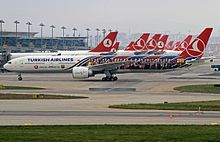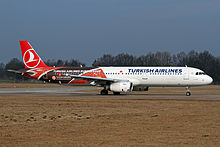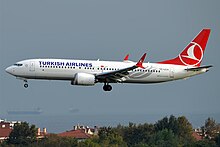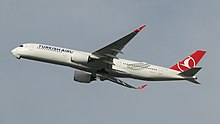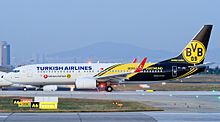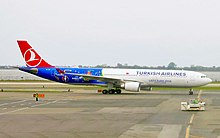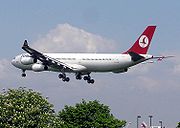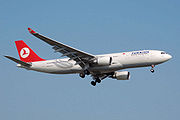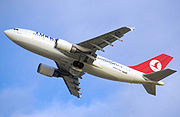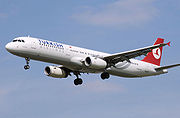Management
Bilal Ekşi
CEO / Member of the Board
Bilal Ekşi graduated from Yıldız Technical University, the Department of Electronics and Communications Engineering in 1989. Starting his career in 1989, Mr. Ekşi worked as an Electronics and Communications Engineer at Turkish State Railways and thereafter, he was assigned to the position of Workshop Manager at Istanbul Ulasim A.S., and he played an active role in realization of significant transport projects.
As the Head of Overhaul Workshops at Turkish Airlines Inc., Mr. Ekşi carried out the duty of maintenance of aircraft engines, landing gears and all components between 2003 and 2005. In 2005, he has been assigned as the Chief Ground Operations Officer at Turkish Airlines Inc. Mr. EKŞİ accomplished significant projects, particularly in improvement of the on-time departure performance during his tenure.
Having served as the Chief Production Officer at Turkish Technic in 2008 and 2009; and as the General Manager of Cyprus Turkish Airlines as part of the reorganization of Cyprus Turkish Airlines in 2010; and as the Executive Vice President at «Turkish Engine Center (TEC)», established by the Joint Venture of Pratt Whitney, the American Engine manufacturer, and Turkish Technic Inc. between 2010 – 2011; Mr. Ekşi was assigned as the Director General of Civil Aviation in April 2011. During his tenure as the Director General of Civil Aviation, Türkiye has been reelected as a member of Council of International Civil Aviation Organization (ICAO) 66 years later its pervious membership and has become one of the 36 members in ICAO’s decision-making platform.
On 21st of October, 2016, he was assigned as the CEO and continues his duty as the CEO and Member of the Board.

Assoc. Prof. Murat Şeker
Chief Financial Officer / Member of the Board of Directors and the Executive Committee
Dr. Murat Şeker, PhD earned his undergraduate degree in Industrial Engineering from Marmara University in 2000, followed by a Master’s Degree in Economics from Sabancı University in 2002. Then, he earned a PhD in Economics from University of Minnesota, USA in 2008.
Dr. Şeker worked as an Economist at Financial and Private Sector Development Vice Presidency of World Bank, USA between 2008 and 2013. During his tenure at the World Bank, he was responsible for operational project management; production of policy reports and research publications on innovation, entrepreneurship, international trade, and growth in developing countries.
Between 2013 and 2016, Dr. Şeker worked at Ziraat Bank as Senior Vice President of Financial Institutions and Investor Relations Department where he was responsible for international financing; managing the relationship with all financial institutions and investors. During this period, Dr. Şeker also served as Board Member of Ziraat Investment, Ziraat Private Pension and Ziraat Insurance subsidiaries.
In July 2016, Dr. Şeker was assigned as the Chief Financial Officer of Turkish Airlines. In Turkish Airlines, he is responsible from finance, treasury, accounting, procurement and investor relations. In March 2021, he was additionally appointed as a Member of the Board and the Executive Committee. Dr. Şeker also serves as a Board Member of Turkish Technic and SunExpress subsidiaries.
Between 2015 and 2018, Dr. Şeker lectured as part-time professor at Boğaziçi University, Faculty of Economics and Administrative Sciences and received Associate Professorship title in October 2018.

Ahmet Olmuştur
Chief Marketing Officer
Born in 1980 in Istanbul, Ahmet Olmuştur completed his primary and secondary education in Istanbul and then received his bachelor’s degree in business administration from the Marmara University School of Business. He went on to complete his graduate studies with an MBA from Long Island University Brookville (New York), after studying at the European Business School (London) and Pole Universitaire Leonard de Vinci (Paris).
He began his career working part-time at the Turkish Airlines call center in 2000. After completing his graduate studies, he continued his career as a flight analyst in the Department of Revenue Management, after which he served in a number of roles working with General Distribution Systems, Revenue Management and Pricing in the same department. He was later appointed Head of Revenue Management. Since 2014, he has been serving as Deputy General Manager Chief Marketing and Sales Officer. He is also a member of the Air Albania Board of Directors, member of the Sunexpress Board of Directors and the Audit Committee.
Mr. Olmuştur is in charge of planning and implementing the flight network for the main Turkish Airlines brand and is responsible for planning scheduled flights as well as additional flights, for setting and optimizing ticket prices, for sales and sales channels, marketing, customer experience, Miles&Smiles and corporate communications.
Ahmet Olmuştur is fluent in English and speaks Arabic at a beginner level. He is also able to read and write Ottoman Turkish. Mr. Olmuştur is a member of the Board of Directors and Board of Trustees at Prof. Dr. Fuat Sezgin Research Foundation for the History of Science in Islam. He is married and has three children.
Kerem Sarp
Chief Commercial Officer
Mr. Kerem Sarp was born in 1976 in Amasya, Türkiye. He completed his bachelors degree in Accounting and Finance from İzmir Dokuz Eylül University and MBA from İstanbul University. After graduation, Mr. Sarp started his early career as a Finance and Accounting specialist at TNT Cargo and Bilginler A.S. between 2001 – 2005. Then, he joined Turkish Airlines as a Sales and Marketing specialist in 2005. In 2009, he was assigned as General Manager of Venice, Italy. Mr. Sarp was appointed as Vice President of Sales and Marketing of South Europe in 2014 and then, in 2015, he worked as Senior Vice President of Sales (II. Region) until 2022. In February 2022, he started serving as Chief Commercial Officer. He is also acting as a board member of Turkish Opet Aviation Fuels Inc.
As Chief Commercial Officer, Mr. Sarp is responsible for AnadoluJet, Catering and Inflight Products and Ground Operations Directorate within Turkish Airlines.
Mr. Sarp is fluent in English. He is married and has two children.
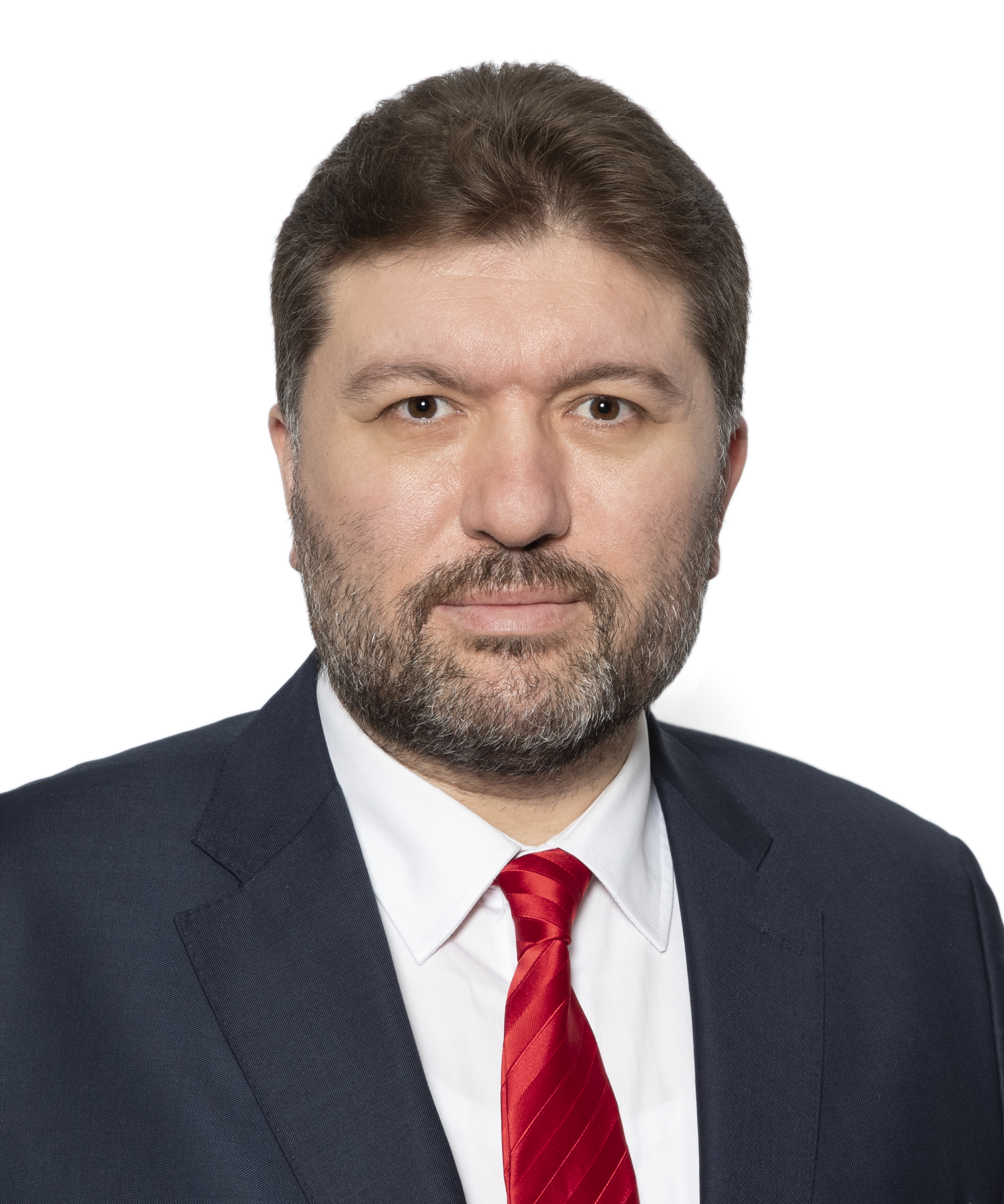
Levent Konukcu
Chief Investment & Technology Officer
Mr. Levent Konukcu was born in 1975 in Eskişehir, Türkiye and received his Bachelor’s Degree in Aeronautical Engineering from Istanbul Technical University.
Mr. Konukcu started his early career working as an engineer in several midsize companies. He started his career at Turkish Airlines in 2003 as an engineer in the engine shop under the management of Chief Technical Officer and beginning in 2004, he continued to work as an engineer under Strategic Planning Management. In 2009, Mr. Konukcu was appointed as the Fleet Planning and Aircraft Acquisition Manager and served as the SVP of Investment Management between 2012 and 2020. With his career of almost 17 years in Turkish Airlines, he took part in the preparation of the Company’s strategical plans, investment plans and fleet plans. He also played an active role in the leasing or purchasing of nearly 550 aircraft. The number of aircraft in the Company’s fleet rose from 65 aircraft in 2003 to 365 aircraft in 2020 when he left the Company. Mr. Konukcu played a significant role in the establishing of the Flight Training Center which would reach the capacity of 29 flight simulators and the Flight Training Academy which had 27 training aircraft. Mr. Konukcu also coordinated the move of the passenger operations from Atatürk Airport to Istanbul Airport, which was completed in 2019.
Mr. Konukcu served as the Vice President of Strategy and Affiliates Management in Turkish Aerospace Industry between September 2020 and January 2022. He also served as the acting Vice President of Corporate Marketing and Communications for about 2.5 months. In this period, the 10 year strategy plan of the company was prepared and process improvement activities were expedited.
Having begun serving as the Chief Investment & Technology Officer at Turkish Airlines in February 1, 2022, Mr. Konukcu is responsible for strategical planning, fleet planning, aircraft and aircraft related major investments, management of the international relations, especially Star Alliance, management of the innovation activities and activities relating to sustainability.
Mr. Konukcu is fluent in English. He is married and has three children.
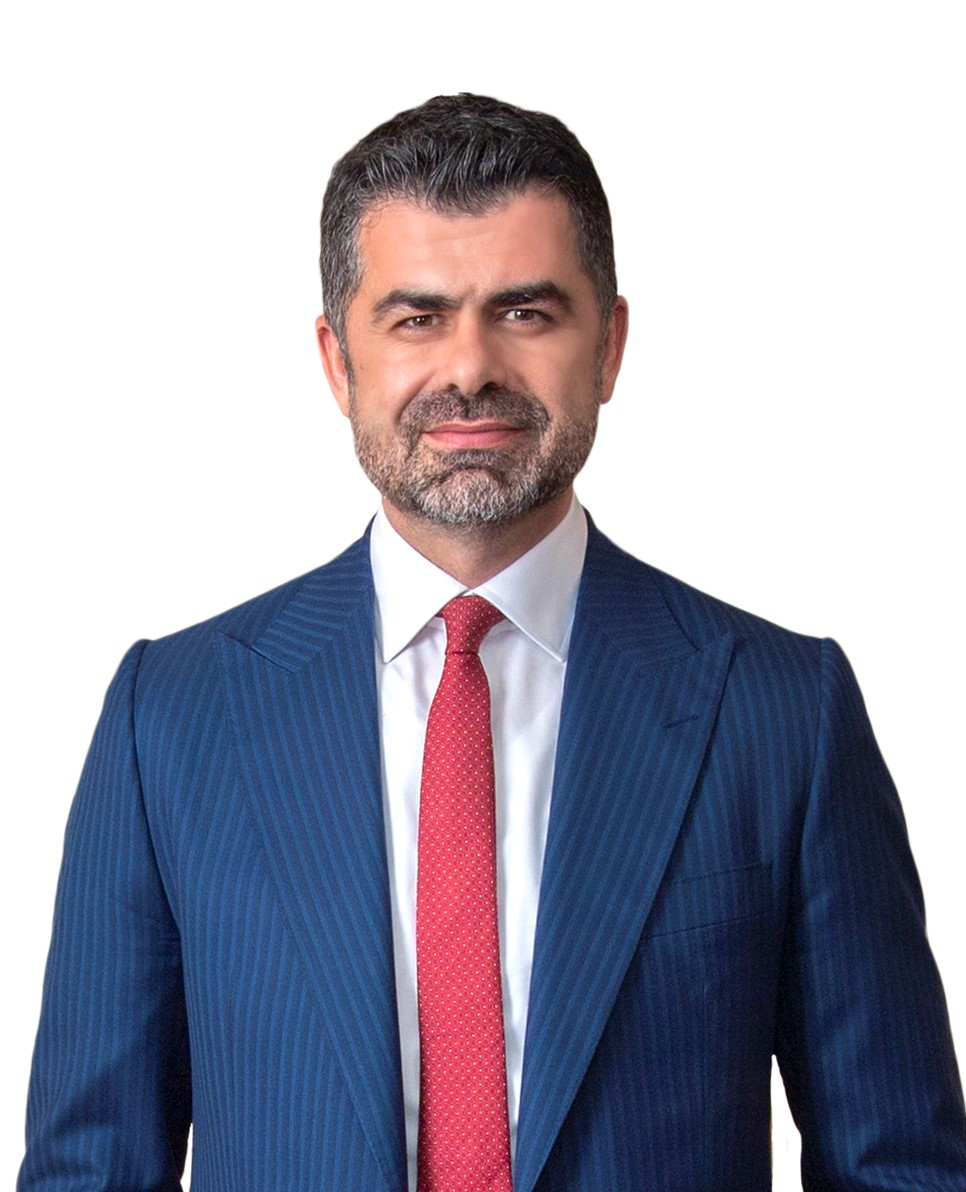
Abdulkerim Çay
Chief Human Resources Officer
Born in 1981 in Amasya, Türkiye, Abdulkerim Çay holds a degree in Political Science and International Relations from Boğaziçi University in Istanbul. Mr. Çay also completed the Executive MBA program at the same university.
Beginning his professional career in the Prime Ministry of Türkiye as a Press and Public Relations Advisor in 2004, Çay took part in the establishment of the Prime Ministry Investment Support and Promotion Agency of Türkiye (ISPAT) in 2006 where he held senior positions including Vice Presidency until he left for private sector in 2010.
Çay served as an executive in various companies before assuming the position of Chief Human Resources Officer at Turkish Airlines in April, 2015. He also currently serves as the Chairman of the Board Directors of THY Flight Training and Airport Operations Inc. and Turkish Support Services Inc.
Fluent in English and beginner in Arabic and French, Çay is married with four kids.
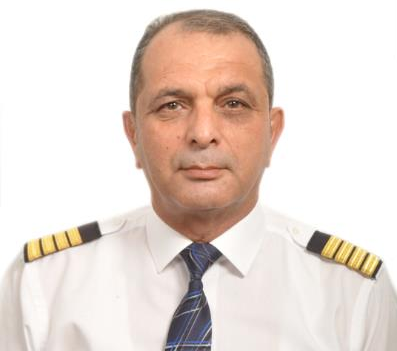
Mehmet Kadaifçiler
Chief Flight Operations Officer
Mehmet Kadaifçiler, who was born in Konya in 1963, completed his undergraduate education in the Turkish Air Force Academy, Department of Aircraft, and graduated in 1986.
Between 1986 and 2000, he served as a jet pilot and an instructor pilot in various units of the Turkish Air Force.
He completed his master’s degree at Turkish Air Force Academy between 2000 and 2002. As a Staff Officer, he retired in 2005 after serving as a Squadron Commander and working in the Turkish Air Force Headquarters Flight Training Department. He joined Turkish Airlines as a First Officer in 2006 and was appointed as a Captain Pilot in 2009.
In Turkish Airlines, he served as the Quality Assurance Directorate Inspector, Quality Assurance (Flight Operations) Manager and Executive Vice President of Flight Operations (Chief Pilot). Between the years 2022 and 2023, he served as a member of the Board of Directors and the Executive Committee and as Chief Flight Operations Officer. Currently, Kadaifçiler continues his duty as Chief Flight Operations Officer.
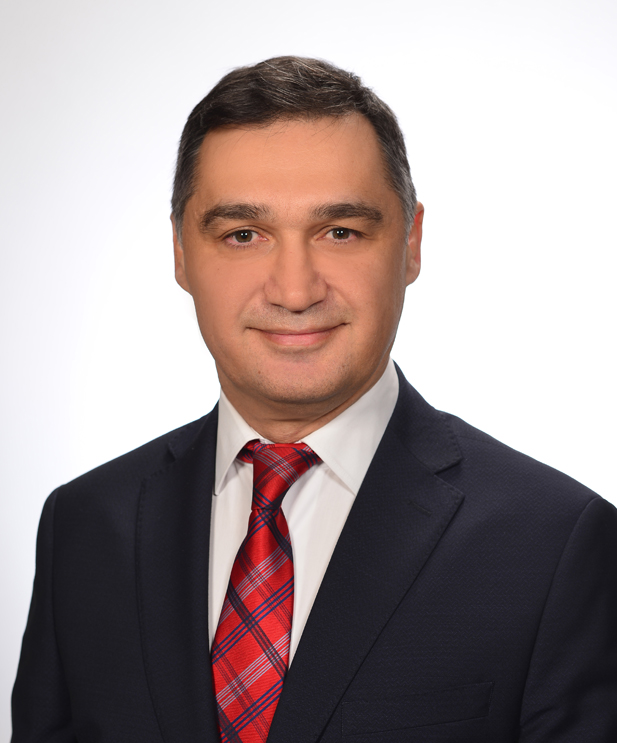
Dr. Kerem Kızıltunç
Chief Information Technology & Transformation Officer
Dr. Kerem Kızıltunç earned his Bachelor’s Degree and Master’s degree in Computer Engineering from Boğaziçi University in 1996 and 1999, respectively. He earned PhD in Business Management from İstanbul Bilgi University in 2019. He started his early carrier as Software Development Engineer in Bilko Otomasyon between 1998-1999. Dr. Kızıltunç worked as Software Development Engineer at Teradata between 1999-2003 and Microsoft Development Center between 2003-2006 in Denmark. Then, he was promoted as Senior Development Leader at Microsoft Development Center.
Dr. Kızıltunç joined Turkish Airlines as Vice President of IT in 2009. In the period of his vice presidency, he built an 8-year roadmap for the domain solutions, technology modernization, and new business projects and he leaded numerous strategic projects. After serving as Senior Vice President between 2013 – 2016 at Turkish Airlines, Mr. Kızıltunç served as Director in Enterprise IT department between 2017 – 2022 at Turkcell.
In March 2022, Mr. Kızıltunç rejoined Turkish Airlines started to serve as the Chief Information Technology & Transformation Officer and General Manager of THY Teknoloji ve Bilişim A.Ş which strategically aims to produce global software products.
Fluent in English and intermediate in Danish, Dr. Kızıltunç is married with two children.

Turhan Özen
Chief Cargo Officer
Turhan Ozen’s near 33-year work experience involves sales, marketing, business development, logistics and supply chain related areas. After graduating from Galatasaray High School, he began studying at the Department of Management at Bogazici University. Later, he got his Executive MBA at Koç University.
He started his early career as the manager of the sales and logistics departments for the Koç Group’s affiliates in the automotive sector where he later became logistics manager. He worked as the Distribution Operations Group Manager and Operations Director at TNT Logistics, where he had been involved since its establishment in Türkiye.
Between 2012 and 2014, he was occupied as Vice President of Business Development & Sales at CEVA Balkans-Middle East and Africa Region.
Later in 2015, he was appointed to the position of CEVA Global Health Sector President. He served as the Managing Director of CEVA Logistics Middle East and North Africa region until he joined the Turkish Airlines family in December 2016. He is acting as Chief Cargo Officer, in charge of Turkish Cargo and board member of We World Express and several other industry affiliates.
He is married with two children.
 |
||||||
|
||||||
| Founded | 20 May 1933; 90 years ago | |||||
|---|---|---|---|---|---|---|
| AOC # | TQKF144F | |||||
| Hubs | Istanbul Airport[1] | |||||
| Frequent-flyer program | Miles&Smiles | |||||
| Alliance | Star Alliance | |||||
| Subsidiaries |
|
|||||
| Fleet size | 400 | |||||
| Destinations | 340 | |||||
| Traded as | BİST: THYAO | |||||
| Headquarters | Atatürk Airport Yeşilköy, Istanbul, Turkey |
|||||
| Key people |
|
|||||
| Revenue | ||||||
| Operating income | ||||||
| Net income | ||||||
| Total assets | ||||||
| Total equity | ||||||
| Employees | 37,670 (2020)[6] | |||||
| Website | www |
Turkish Airlines (Turkish: Türk Hava Yolları) or officially Türk Hava Yolları Anonim Ortaklığı[7] is the flag carrier of Turkey.[8] As of 2022, it operates scheduled services to 340 destinations in Europe, Asia, Africa, and the Americas,[9] making it the largest mainline carrier in the world by number of passenger destinations.[10][11][12] The airline serves more destinations non-stop from a single airport than any other airline in the world[13] and flies to 126 countries, more than any other airline.[11][12][14][15] With an operational fleet of 24 cargo aircraft, the airline’s cargo division Turkish Cargo serves 82 destinations.[16]
The airline’s corporate headquarters are at the Turkish Airlines General Management Building on the grounds of Istanbul Atatürk Airport in Yeşilköy, Bakırköy, Istanbul.[17] Istanbul Airport in Arnavutköy is the airline’s main base, and there are secondary hubs at Ankara Esenboğa Airport and Izmir Adnan Menderes Airport. Turkish Airlines has been a member of the Star Alliance network since 1 April 2008.[18]
History[edit]
Early years[edit]
Turkish Airlines was established on 20 May 1933 as Turkish State Airlines (Turkish: Devlet Hava Yolları)[19] as a department of the Ministry of National Defense.[20] The airline’s initial fleet consisted of two five-seat Curtiss Kingbirds, two four-seat Junkers F 13s and one ten-seat Tupolev ANT-9.[20] In 1935, the airline was turned over to the Ministry of Public Works and was subsequently renamed General Directorate of State Airlines. Three years later, in 1938, it became part of the Ministry of Transportation.[21]
Postwar period[edit]
Several Douglas DC-3s and Douglas C-47s were phased in during 1945.[22] Being initially set up as a domestic carrier, the airline commenced international services with the inauguration of Ankara–Istanbul–Athens flights in 1947; with the DC-3s and C-47s enabling the carrier to expand its network.[20]
Nicosia, Beirut and Cairo were soon added to the airline’s international flight destinations. However, domestic services remained the carrier’s primary focus until the early 1960s.[23]
In 1956, the Turkish government reorganized the airline under the name Türk Hava Yolları A.O. (often abbreviated as THY).[20] It was capitalized at TRY 60 million. The airline joined the International Air Transport Association (IATA) shortly thereafter. In 1957, British Overseas Airways Corporation (BOAC) began supplying technical support after acquiring a 6.5 percent shareholding, which it held for about 20 years.[23]
New aircraft including Vickers Viscounts, Fokker F27s and Douglas DC-3s were added to the fleet in the late 1950s and early 1960s. Turkish Airlines began operating their first jet, a McDonnell Douglas DC-9, in 1967. This was followed by the addition of three Boeing 707 jets in 1971. Other aircraft operated in the early 1970s included the McDonnell Douglas DC-10 and the Fokker F28 which were put into service in 1972 and 1973 respectively.[20][23]
1980s and 1990s[edit]
The airline was plagued by several issues in the 1980s and 90s. It developed a reputation for poor service compared to competitors and flight delays, with 47 out of 100 flights not departing on time.[24] It also endured hijackings and suffered seven accidents between 1974 and 1983. The most notorious was the 1974 crash of Turkish Airlines Flight 981, when an aircraft design flaw led to a faulty cargo door breaking off in flight near Ermenonville, France, resulting in the deaths of 346 people.
A new government came to power in 1983 which recognized THY’s importance as Turkey’s gateway to the world, beginning the airline’s makeover into a modern operation. It would go on to maintain one of the youngest fleets in the world. Security was intensified, causing one shipper to compare it to Israel’s El Al, at least in terms of delays.[23]
THY built a new, state-of-the-art technical center at Yeşilköy Airport in 1984. The airline was capable of both light and heavy maintenance on many different aircraft types. The technical staff then made up one-quarter of the airline’s 6,000 employees, according to Air Transport World. In 1984, the company’s capital was raised to 60 billion TL as it was classified as a state economic enterprise. Three years later, the capital was raised again, to 150 billion TL.
By the mid-1980s, THY had a fleet of 30 aircraft. It was flying approximately three million passengers a year to 16 domestic destinations and three dozen international ones. The airline was Turkey’s largest source of foreign currency. Turkish Airlines began operating Airbus A310s in 1985, allowing the addition of flights to Singapore in 1986. A route to New York City via Brussels was added in 1987.[25]
The company posted losses in 1987 and 1988, largely due to high payments on its dozen new Airbus A310s, according to Air Transport World. The fleet also included 11 Boeing 727s and nine Douglas DC-9s. THY ended the decade with 8,500 employees.[23]
The airline ordered five Airbus A340 aircraft with option for five more in 1990 to be able to fly to North American and East Asian destinations non-stop. The first A340 was delivered three years later, in 1993.[26]
The company suffered in the global aviation crisis following the Persian Gulf War and would not break-even again until 1994. However, the business was again booming in the mid-1990s, with the greatest growth coming from North American destinations.[citation needed] THY launched a nonstop flight to New York City in July 1994.
The company’s capital continued to be raised, reaching 10 trillion TL in 1995. During that year, the airline also converted three of its Boeing 727s to dedicated freighters. The DC-9s had been sold off. The company posted a $6 million profit on revenues of $1 billion for the year. While profitable, THY had to contend with Turkey’s exorbitant inflation, making capital improvements difficult.
The domestic market was deregulated in 1996, allowing new scheduled competition from charter airlines. At the same time, larger international carriers were providing stiff competition on routes to Western Europe. THY entered into marketing agreements with other international airlines to enhance their competitiveness. The company teamed with Japan Airlines to offer service to Osaka and Tokyo in 1997 and 1998. Other jointly operated flights soon followed with Austrian Airlines, Swissair, and Croatia Airlines.[23] In 1997, THY began to operate flights to Chicago as its second destination in the US.[27]
21st century[edit]
A new terminal opened in January 2000 at Istanbul’s Istanbul Atatürk Airport. Turkish Airlines continued to extend their international reach, forging marketing agreements with Asiana Airlines, American Airlines, Malaysia Airlines, LOT Polish Airlines, Czech Airlines and Cathay Pacific in 2000. On 29 October 2000, THY withdrew from the Swissair-led Qualiflyer alliance to help attract a strategic investor for their privatization.[23][29] The airline had been part of the alliance’s frequent-flyer program since November 1998.[29] An Antalya-Frankfurt route was added in 2001 through a code-sharing agreement with Sun Express.
Turkey underwent an economic crisis throughout most of 2001, leading to a reduction in traffic on domestic routes in particular. THY managed to survive after the September 11 attacks on the United States without a government bailout or mass layoffs, although 300 middle management positions were eliminated, 400 part-timers were laid off and wages were cut 10 percent. Turkish Daily News credited the airline’s survival to entrepreneurial management, which was quick to get rid of loss-making routes at home and abroad.[citation needed]
In 2003, the war in Iraq prompted Turkish Airlines to close some routes in the Persian Gulf, while flights to Asia were suspended during the SARS epidemic. However, the airline soon recovered, increasing traffic on existing routes and adding service to Delhi after an 11-year lapse.
Another fleet expansion program kicked off in 2004, helping THY maintain one of the youngest fleets in Europe. In July that year, the airline announced a massive $2.8 billion order of 36 jets from Airbus, plus an order for 15 Boeing 737s.
THY was not just ordering new planes. It was planning to spend $350 million on a new technical and training facility at Istanbul’s underutilized Sabiha Gökçen International Airport. The airline had built up a significant technical services operation, maintaining not just their aircraft but those of third parties. Turkish Technic employed 2,700 workers and was planning to hire another 2,000 by 2010. THY also had three flight simulators and offered flight training services.
The airline faced the entry of new competitors into the liberalizing Turkish aviation market. However, tourism was booming, with 20 million people expected to visit the country in 2005 versus 12 million in 2003. THY divested its 50% holding in Cyprus Turkish Airlines (Kıbrıs Türk Hava Yolları) in 2005.
Although the company was publicly traded at this time, the government-owned 98% of its shares. The privatization program was revived in 2004 with a public offering of 20% of shares on the Istanbul Stock Exchange. The Turkish government-owned 75% of shares after the offering, which raised $170 million. Currently, the Republic of Turkey’s Prime Ministry Privatization Administration owns a 49.12% interest in THY, while 50.88% of shares are publicly traded.[30]
On 1 April 2008, Turkish Airlines joined the Star Alliance after an 18-month integration process beginning in December 2006, becoming the seventh European airline in the 20-member alliance.[31]
In December 2011, the Turkish government unveiled plans to modernize the Aden Adde International Airport in Mogadishu, Somalia, which became one of the newest flight destinations of the carrier in 2012. The rehabilitation project is part of Turkey’s broader engagement in the local post-conflict reconstruction process. Among the scheduled renovations are new airport systems and infrastructure, including a modern control tower to monitor the airspace.[32] In March 2012, Turkish Airlines became the first international carrier to resume flights to Somalia since the start of that country’s civil war in the early 1990s.
By the end of 2013, Turkish Airlines had increased their number of flight points to 241 destinations worldwide (199 international and 42 domestic).[33]
In the wake of the 2016 Turkish coup d’état attempt, the Federal Aviation Administration temporarily banned flights between Turkey and the United States. This posed a particular problem for Turkish Airlines as a key component of the airline’s strategy was to deliver one-stop journeys between the US and hard-to-reach destinations in Africa, the Middle East, and India.[34] This ban was lifted on 18 July, and Turkish Airlines resumed flights to the U.S. on 19 July after a three-day disruption.[35]
In August 2016, Turkish Airlines announced a profit collapse to a loss of 198 million Euros for the second quarter of 2016 while expecting an overall loss of 10 million passengers for 2016.[36] The airline already announced significant reductions in operations for the upcoming 2016–2017 schedule period with frequency cuts to 45 European and 13 intercontinental routes.[37][38] Turkish Airlines also announced an overall record loss of 1.9 billion Turkish Lira ($644.4 million) for the first half of 2016.[39]
The following year saw the airline recover, with financial results for 2017 showing an almost 35% increase in turnover, and a return to profitability.[40]
In February 2022, Turkish Cargo, the airline’s freight subsidiary, relocated all cargo flights and operations from their former base at Istanbul Atatürk Airport to the new Istanbul Airport.[41][42]
In February 2023, Turkish Airlines confirmed plans to spin-off AnadoluJet from an incorporated brand name into an independent airline.[43]
Corporate affairs[edit]
The airline head office is in the Turkish Airlines General Management Building at Istanbul Atatürk Airport in Yeşilköy, Bakırköy.[44]
Key people[edit]
On 26 January 2022, İlker Aycı resigned from his position as chairman of the airline.[45] During the board meeting the next day, Ahmet Bolat was elected to become the new chairman.[46][47] Bilal Ekşi holds the deputy chairman and CEO positions.[48]
Business trends[edit]
The key trends for Turkish Airlines for the past 15 years are shown below (as of December 2018):[49][50][51]
| 2003 | 2004 | 2005 | 2006 | 2007 | 2008 | 2009 | 2010 | 2011 | 2012 | 2013 | 2014 | 2015 | 2016 | 2017 | 2018 | |
|---|---|---|---|---|---|---|---|---|---|---|---|---|---|---|---|---|
| Turnover (₺m) | 2,846 | 2,593 | 2,956 | 3,812 | 4,860 | 6,123 | 7,036 | 8,423 | 11,813 | 14,909 | 18,777 | 24,158 | 28,752 | 29,468 | 39,779 | 62,853 |
| Net profit (₺m) | 243 | 107 | 138 | 179 | 265 | 1,134 | 559 | 286 | 19 | 1,133 | 683 | 1,819 | 2,993 | -47 | 639 | 4,045 |
| Number of passengers carried (m) | 10.4 | 12.0 | 14.1 | 16.9 | 19.6 | 22.6 | 25.1 | 29.1 | 32.6 | 39.0 | 48.3 | 54.7 | 61.2 | 62.8 | 68.6 | 75.1 |
| Passenger load factor (%) | 67 | 70 | 72 | 69 | 73 | 74 | 71 | 74 | 73 | 77 | 79 | 79 | 78 | 74 | 79 | 82 |
| Cargo carried (000s tonnes) | 123 | 135 | 145 | 160 | 183 | 199 | 238 | 314 | 388 | 471 | 565 | 668 | 720 | 876 | 1,123 | 1,412 |
| Number of aircraft (at year end) | 65 | 73 | 83 | 103 | 102 | 127 | 134 | 153 | 179 | 200 | 233 | 261 | 299 | 334 | 329 | 332 |
| Number of destinations (at year end) | 103 | 102 | 107 | 134 | 138 | 142 | 156 | 171 | 189 | 217 | 243 | 264 | 284 | 295 | 300 | 306 |
| Sources | [52][53] | [53][54] | [53][55] | [53][56] | [57][58] | [59][60] | [61][62] | [63][64] | [65][66] | [65][66] |
[2][67] |
[68] | [69][70][71] | [72] | [40] |
[73][74] |
Destinations[edit]
As of 2022, Turkish Airlines flies to 340 destinations in 129 countries, including 53 domestic and 12 in the United States.[9][75]
Codeshare agreements[edit]
Turkish Airlines codeshares with the following airlines:[76]
- Aegean Airlines
- Air Albania
- Air Algérie
- Air Astana
- airBaltic[77]
- Air Canada
- Air China
- Air Europa
- Air India
- Air Malta
- Air Moldova
- Air New Zealand
- Air Serbia[78]
- All Nippon Airways
- AnadoluJet[79]
- Asiana Airlines
- Avianca
- Azerbaijan Airlines
- Azul Brazilian Airlines
- Bangkok Airways
- Batik Air Malaysia[80]
- Belavia[81][82]
- Copa Airlines[83]
- Croatia Airlines
- EgyptAir
- Ethiopian Airlines
- Etihad Airways
- EVA Air
- Finnair[84]
- Garuda Indonesia
- Gol Linhas Aéreas Inteligentes[85]
- Gulf Air[86]
- Hawaiian Airlines
- Hong Kong Airlines
- Icelandair[87]
- IndiGo[88]
- JetBlue
- Kuwait Airways
- LOT Polish Airlines
- Lufthansa[89][90]
- Luxair
- Malaysia Airlines[91]
- MIAT Mongolian Airlines[92]
- Middle East Airlines
- Oman Air
- Pakistan International Airlines
- Philippine Airlines
- Royal Air Maroc
- Royal Brunei Airlines
- Royal Jordanian
- RwandAir
- Scandinavian Airlines
- Singapore Airlines
- TAP Air Portugal
- TAROM[93]
- Thai Airways
- Ukraine International Airlines
- United Airlines
- Utair
- Uzbekistan Airways[94][95]
Interline agreements[edit]
Turkish Airlines has interline agreements with the following airlines:[96][97]
- Austrian Airlines
- Loganair[98]
- Swiss International Air Lines
Fleet[edit]
As of March 2023, Turkish Airlines operates a fleet of 400 aircraft,[99] consisting of 13 passenger aircraft types.[100] The airline started operations in 1933 with five aircraft, which grew to 52 in 1945 after the addition of Douglas DC-3s used in the Second World War.[101][102] This made Turkish Airlines the largest carrier in the Middle East.[103] The first jet-engined aircraft of the airline was a Douglas DC-9, which joined the fleet in 1967.[104] The first wide-body Douglas DC-10 was added in 1972.[105] The airline made major changes to its fleet development in late-1980s,[106] when the first Airbus A310 arrived,[24] and the Airbus A340 was ordered.[107] The first Boeing 737s arrived a few years later.[108]
Throughout 2004, the airline ordered over 50 aircraft both from Boeing and Airbus.[109] Three Boeing 777-300s were leased in 2008,[110] and later ordered 12 more from Boeing.[111] In 2013, the airline ordered almost 200 aircraft.[112][113] The airline ordered 25 each of the Boeing 787-9 and Airbus A350-900 in March 2018,[114] which started delivery in 2019 and 2020 respectively.[115][116]
The airline announced on 11 May 2023, that they will be purchasing around 600 new aircraft which will arrive in a period of 10 years. The Chairman of the Board of Directors and the Executive Committee, Ahmet Bolat has said that the majority of the aircraft will be Boeing, with some being from «another manufacturer»[117]
Frequent-flyer programme[edit]
Miles & Smiles is the frequent-flyer programme of Turkish Airlines, inaugurated in 2000 after the airline left Qualiflyer.[118] Earned miles can be used on Turkish Airlines flights, as well as on flights operated by the entire Star Alliance network. Miles&Smiles Classic Plus members are entitled to Star Alliance Silver benefits, while Elite and Elite Plus Miles & Smiles status entitles the member to Star Alliance Gold benefits.[119]
Miles & Smiles Credit Card[edit]
Members of the frequent flyer programme also earn miles when paying their purchases with their Miles & Smiles credit card. Currently residents of Turkey, Israel and Azerbaijan are offered with Miles & Smiles credit card by programme member local banks. Credit cards can be issued in form of American Express, Mastercard and/or Isracard.[120][121]
There are also agreements with specific banks in countries across America, Asia and Oceania for earning and spending miles.[122]
Turkish Airlines Corporate Club[edit]
Turkish Airlines Corporate Club is a kind of programme created for corporates. The Club allows its members to easily arrange business travels with special benefits.[123]
The Corporate Club is a part of Universal Air Travel Plan Network (UATP).[124]
Sponsorship and promotion agreements[edit]
Turkish Airlines has been the official carrier of several European football clubs such as Galatasaray, Manchester United,[126] FC Barcelona,[127] Borussia Dortmund,[128][129] Olympique de Marseille,[130] Aston Villa,[131] FK Sarajevo,[132] and Hannover 96.[133]
The airline has also made sponsorship and promotion deals with renowned athletes and actors, including[134] Lionel Messi,[135] Kobe Bryant,[135] Caroline Wozniacki,[136] Kevin Costner,[137] Wayne Rooney,[137] and Didier Drogba.[138]
The company has been the primary sponsor of the Turkish Airlines EuroLeague since 2010[139] and was among the sponsors of the 2010 FIBA World Championship.[140]
On 22 October 2013, Turkish Airlines and Euroleague signed an agreement to prolong their existing sponsorship deal by five years until 2020.[141]
Turkish Airlines is the sponsor of the Turkish Airlines Open, a European Tour golf tournament played annually in Turkey since 2013.[142]
Turkish Airlines was the kit sponsor of Galatasaray for the 2014–15 UEFA Champions League and Bosnian club FK Sarajevo. Since then, the airline has continued its sponsorship of Galatasaray and has also been the kit sponsor for the European campaigns of other Turkish clubs such as Trabzonspor and Başakşehir.
On 10 December 2015, Turkish Airlines and UEFA signed a sponsorship deal for the UEFA Euro 2016, becoming the first airline sponsor of UEFA European Championship tournaments.[143][144]
On 29 January 2016, Turkish Airlines announced its partnership with Warner Bros. to sponsor the film Batman v Superman: Dawn of Justice. In the movie, a pivotal scene unfolds aboard a Turkish Airlines A330.[145] That year, the airline also teamed up with a number of Turkish tourist agencies in the production of the romantic comedy film Non-Transferable.[146]
On 14 September 2018, Turkish Airlines and Lega Basket Serie A,[147] the top-tier professional basketball league in Italy, signed a sponsorship agreement, making the airline an official partner for the 2018–19 LBA season.[148][149]
In February 2019, Turkish Airlines arranged to become partial sponsors for League of Ireland First Division side Drogheda United.[150]
In August 2019, Turkish Airlines reached an agreement with Club Atlético River Plate to become the main sponsor of the Argentine sports club for the next three seasons.[151]
Prior to the start of the 2022–23 season, Turkish Airlines becomes the official global sponsors of the UEFA Champions League and the Super Cup, UEFA Youth League and the Futsal Champions League for the remainder of the 2021–24 cycle after UEFA agreed to sponsor in the next 2 seasons.[152]
Turkish Airlines Flight Academy[edit]
Turkish Airlines Flight Academy (TAFA) was established by the 28th THY Board on 10 November 2004, and started training with 16 cadets on 1 May 2006. The Flight Academy is based at Istanbul Atatürk Airport and uses Aydın Çıldır Airport for training activities.[153][154][155]
The ever-growing flight academy fleet consists of the following 25 aircraft, 19 of which are single-engine and 6 of which are multi-engine aircraft:[156]
- 13 Cessna 172S NAVIII
- 6 Diamond DA-40
- 6 Diamond DA-42 NG
Turkish Airlines Maintenance Center[edit]
Turkish Airlines’ maintenance, repair and overhaul (MRO) center, Turkish Technic, was incorporated in 2006 and is responsible for the maintenance of Turkish Airlines and other third party aircraft within eight hangars.[157] Capabilities include airframe, landing gear, APU and other subsystems.[158] Turkish Technic opened an engine center in partnership with Pratt & Whitney called TEC (Turkish Engine Center) in January 2010 at Sabiha Gökçen International Airport (SAW). The facility provides engine MRO services to customers worldwide.[159]
Turkish Technic was based at Istanbul Atatürk Airport within two hangars. It bought out MNG Technic along with its hangars, and the main complex moved to SAW with the building of two new hangars.[160] Two smaller hangars are also located at Ankara Esenboğa Airport. Additional hangars are being built at the new Istanbul Airport to accommodate the operator’s growing fleet.[161]
Incidents and accidents[edit]
In its history, Turkish Airlines has suffered a total of 19 incidents and accidents of which 15 were fatal. A total of 68 crew, 835 passengers and 35 people on the ground have been killed.
- On 17 February 1959, a Vickers Viscount Type 793, registration TC-SEV, operating a charter flight carrying Turkish Prime Minister Adnan Menderes and a governmental delegation to London for the signing of the London-Zürich Agreements, crashed in dense fog on approach to London Gatwick Airport. Nine of the sixteen passengers and five of the eight crew lost their lives. Adnan Menderes, who was sitting in the back part of the aircraft, survived the accident.[162]
- On 23 September 1961, Turkish Airlines Flight 835, a Fokker F27-100 registered as TC-TAY, crashed at Karanlıktepe in Ankara Province on approach to Esenboğa Airport. All of the 4 crew and 24 of the 25 passengers on board were killed.[163]
- On 8 March 1962, a Fairchild F-27, registration TC-KOP, crashed into the Taurus Mountains on approach to Adana Şakirpaşa Airport. All three crew and all eight passengers on board died.[164]
- On 3 February 1964, a Douglas C-47, registered as TC-ETI, on a domestic cargo flight, flew into terrain whilst on approach to Esenboğa Airport, Ankara. All three crew members on board were killed.[165]
- On 2 February 1969, a Vickers Viscount Type 794, registered as TC-SET, crashed on approach to Esenboğa Airport. There were no casualties.[166]
- On 26 January 1974, Turkish Airlines Flight 301, a Fokker F28-1000 registered as TC-JAO crashed shortly after takeoff from Izmir Cumaovası Airport due to atmospheric icing on the wings. The aircraft disintegrated and caught fire, killing 4 of the 5 crew and 62 of the 68 passengers on board.[167]
- On 3 March 1974, Turkish Airlines Flight 981, a McDonnell Douglas DC-10 registered as TC-JAV, crashed into Ermenonville Forest, Fontaine-Chaalis, Oise, France, due to explosive decompression, killing all 335 passengers and 11 crew on board. The main cause was a design fault on the cargo doors of the McDonnell Douglas DC-10 which led to incomplete engagement of the door locking mechanism on the aircraft in question, and consequent opening of one door in flight.[168][169]
- On 30 January 1975, Turkish Airlines Flight 345, a Fokker F28-1000 registration TC-JAP, crashed into the Sea of Marmara during final approach to Istanbul Yeşilköy Airport. All 4 crew and all 38 passengers on board the aircraft were killed.[170]
- On 19 September 1976, a Boeing 727-200 registered as TC-JBH operating Turkish Airlines Flight 452 from Istanbul Yeşilköy Airport to Antalya Airport struck high ground in the Karatepe Mountains during an attempted landing in Isparta instead of Antalya by pilot error. All eight crew and 146 people on board the aircraft perished in the accident.[171]
- On 23 December 1979, a Fokker F28-1000, registration TC-JAT, on a flight from Samsun-Çarşamba Airport to Esenboğa Airport, struck a hill in Kuyumcuköy village in Çubuk, Ankara, 32 km (20 mi) northeast of its destination airport in severe turbulence. Three of the four crew and 38 of the 41 passengers on board were killed.[172]
- On 16 January 1983, Turkish Airlines Flight 158, a Boeing 727-200 registered as TC-JBR, landed about 50 m (160 ft) short of the runway at Esenboğa Airport in driving snow, broke up and caught fire. All of the 7 crew survived; however, of the 60 passengers on board, 47 were killed.[173]
- On 29 December 1994, Turkish Airlines Flight 278, a Boeing 737-400 registration TC-JES, crashed during its final approach to Van Ferit Melen Airport in driving snow. Five of the seven crew and 52 of the 69 passengers died.[174]
- On 7 April 1999, Turkish Airlines Flight 5904, a Boeing 737-400 registered as TC-JEP on a repositioning flight, crashed near Ceyhan, Adana shortly after taking off from Adana Şakirpaşa Airport. There were no passengers on board, but all six crew members perished in the accident.[175]
- On 8 January 2003, Turkish Airlines Flight 634, an Avro RJ-100 registration TC-THG, crashed on approach to Diyarbakır Airport, Turkey. Of the 80 people on board, all five crew and 70 passengers were killed.[176]
- On 3 October 2006, Turkish Airlines Flight 1476 en route from Tirana, Albania to Istanbul was hijacked by Turkish citizen Hakan Ekinci in Greek airspace. The hijacker surrendered after a forced landing in Brindisi, Italy.[177]
- On 25 February 2009, Turkish Airlines Flight 1951, a Boeing 737-800 registered as TC-JGE carrying 128 passengers and a crew of 7, crashed during final approach to Amsterdam Airport Schiphol, Netherlands. It was determined that a faulty radar altimeter caused the aircraft to throttle the engines back to idle and that the crew subsequently failed to react properly which resulted in an unrecoverable stall and the subsequent crash. Of the 135 people on board, nine people, including the three pilots, were killed. Eighty-six more people were transported to local hospitals.[178][179][180][181]
- On 3 March 2015, Turkish Airlines Flight 726 departed the runway on landing at Tribhuvan International Airport, Kathmandu, Nepal. The Airbus A330-300 operating the flight, TC-JOC, was severely damaged when its nose gear collapsed, causing damage to the fuselage and both wings. All 227 passengers and 11 crew members on board escaped uninjured.[182] The Aircraft was scrapped afterwards.[183]
- On 25 April 2015, Turkish Airlines Flight 1878, an Airbus A320-200 TC-JPE was severely damaged in a landing accident at Istanbul Atatürk Airport. All on board were successfully evacuated without any injuries reported.[184]
- On 16 January 2017, Turkish Airlines Flight 6491, a Boeing 747-412F operated for Turkish Airlines under wet lease from ACT Airlines, crashed into a residential area upon attempting landing in Manas International Airport in Bishkek, Kyrgyzstan, killing all four crew members and 35 people on the ground.[185][186][187] In response, Turkish Airlines released a statement on Twitter that neither plane nor crew were theirs, calling it an «ACT Airlines accident».[188] However, the flight was still operated under a Turkish Airlines flight number, making it a Turkish Airlines flight under IATA rules.
- On 21 November 2019, Turkish Airlines Flight 467, a Boeing 737-800, suffered a nose gear collapse while attempting to land in heavy crosswinds at Odesa International Airport in Ukraine. All passengers and crew were deplaned using emergency slides without injury.[189] The Aircraft, TC-JGZ, was declared a hull loss and scrapping was commenced in 2020.[190]
See also[edit]
- List of airlines of Turkey
- Aviation in Turkey
References[edit]
Citations[edit]
- ^ «Transfer from Ataturk to Istanbul Airport to begin on 5 April». hurriyetdailynews.com. Archived from the original on 19 April 2020. Retrieved 27 February 2019.
- ^ a b c d «FInancial Statements 2013» (PDF). Turkish Airlines. Archived (PDF) from the original on 19 April 2020. Retrieved 7 March 2014.
- ^ «Türk Hava Yolları THY Destek Hizmetleri A.Ş’yi KAP’a bildirdi». www.dunya.com. Archived from the original on 1 March 2023. Retrieved 1 March 2023.
- ^ a b c d e f «Board Activity Report» (PDF). Turkishairlines.com. 30 September 2019. Archived (PDF) from the original on 9 August 2020. Retrieved 26 November 2019.
- ^ a b c d e «Turkish Airlines Financial Statements 2022» (PDF). Turkishairlines.com. 31 December 2022. Archived (PDF) from the original on 7 March 2023. Retrieved 1 March 2023.
- ^ «Turkish Airlines». Forbes. Archived from the original on 15 November 2022. Retrieved 16 July 2020.
- ^ «Türk Hava Yolları Haberleri». Hürriyet (in Turkish). Archived from the original on 26 April 2023. Retrieved 26 April 2023.
- ^ «Turkish Airlines orders ten incremental A350-900s». ch-aviation GmbH. 4 September 2023. Archived from the original on 9 September 2023.
- ^ a b «Sayılarla Türk Hava Yolları». Turkish Airlines. Archived from the original on 8 May 2020. Retrieved 30 July 2022.
- ^ «Network» (PDF). Investor.turkishairlines.com. Archived (PDF) from the original on 9 August 2020. Retrieved 26 September 2017.
- ^ a b «Turkish Airlines’ net profit triples in 9-month». Anadolu Agency. 7 November 2018. Archived from the original on 9 November 2018. Retrieved 9 November 2018.
- ^ a b Cebeci, Uğur (21 August 2019). «Yeni uçuşlar yakında». www.hurriyet.com.tr (in Turkish). Archived from the original on 23 August 2019. Retrieved 23 August 2019.
- ^ «Best connected airline hubs by region revealed». anna.aero. 29 July 2015. Archived from the original on 6 November 2018. Retrieved 6 November 2018.
- ^ «Sayılarla Türk Hava Yolları». Archived from the original on 8 May 2020.
- ^ «Turkish Airlines Becomes No. 1 in the World, Flying to the Most Countries Worldwide». Businesswire.com. 14 November 2012. Archived from the original on 24 October 2016. Retrieved 24 October 2016.
- ^ «Archived copy» (PDF). Archived from the original (PDF) on 13 June 2021. Retrieved 29 June 2021.
{{cite web}}: CS1 maint: archived copy as title (link) - ^ «Contact Us Archived 25 July 2010 at the Wayback Machine.» Turkish Airlines. Retrieved on 26 June 2010. «Turkish Airlines General Management»
- ^ «Turkish Airlines – Star Alliance». Archived from the original on 8 April 2015. Retrieved 24 April 2015.
- ^ «DHY timetable October 15, 1955». www.timetableimages.com. Archived from the original on 15 October 2019. Retrieved 16 October 2019.
- ^ a b c d e «Turkish Airlines – History». Turkishairlines.com. 17 February 1977. Archived from the original on 21 May 2016. Retrieved 23 May 2016.
- ^ «History of Turkish Airlines». Seatmaestro. Archived from the original on 24 April 2015. Retrieved 24 April 2015.
- ^ Hofmann, Kurt (29 April 2016). «Turkish Airlines to take delivery of 26 Boeing aircraft in 2016». Air Transport World. Archived from the original on 1 May 2016.
Turkish Airlines’ and Boeing’s long history goes back to 1945, with the arrival of the airline’s first DC-3/C-47 airliners.
- ^ a b c d e f g «History of Turkish Airlines Inc. (Türk Hava Yollari A.O.)». FundingUniverse.com. Archived from the original on 11 November 2007. Retrieved 24 April 2015.
- ^ a b Şekerli 2021, p. 863.
- ^ «THY, 87 yılda küresel marka haline geldi». 25 June 2020. Archived from the original on 25 June 2020. Retrieved 25 December 2022.
- ^ Şekerli 2021, p. 865.
- ^ iha.com.tr. «Türk Hava Yolları’nın Chicago’da 20. yılı». İhlas Haber Ajansı (in Turkish). Retrieved 25 December 2022.
- ^ «Turkish Airlines signs sponsorship deal with Barcelona» (Press release). Turkish Airlines. 18 January 2010. Archived from the original on 16 July 2011. Retrieved 20 January 2010.
- ^ a b «THYAO, Qualiflyer Özel Yolcu Programı’ndan Ayrıldı». Hürriyet (in Turkish). 27 October 2000. Archived from the original on 16 October 2019. Retrieved 16 October 2019.
- ^ «Investor Relations». Turkish Airlines. Archived from the original on 26 September 2011. Retrieved 28 November 2013.
- ^ «Turkish Airlines to join Star Alliance, Star Alliance board approves membership application» (Press release). Star Alliance. 9 December 2006. Archived from the original on 13 February 2013. Retrieved 4 May 2012.
- ^ «SKA will run airport operations in Mogadishu». Archived from the original on 19 January 2012. Retrieved 24 April 2015.
- ^ «Turkish Airlines – Destinations and Frequencies». Turkishairlines.com. 17 December 2013. Archived from the original on 19 October 2013. Retrieved 20 February 2014.
- ^ Sumers, Brian (16 July 2016). «FAA Bans Turkish Airlines From Flying to the United States». Skift. Archived from the original on 17 July 2016. Retrieved 16 July 2016.
- ^ Sumers, Brian (18 July 2016). «FAA Lifts Turkish Air Flight Ban». Skift. Archived from the original on 19 July 2016. Retrieved 27 July 2016.
- ^ Rundschau, Frankfurter (20 August 2016). «Fluggesellschaft in den roten Zahlen: Massiver Gewinn-Einbruch bei Turkish Airlines». Frankfurter Rundschau. Archived from the original on 23 January 2019. Retrieved 23 January 2019.
- ^ Ltd. 2019, UBM (UK). «Turkish Airlines W16 Europe/Short-Haul service changes as of 27AUG16». Routesonline. Archived from the original on 16 December 2018. Retrieved 23 January 2019.
- ^ Ltd. 2019, UBM (UK). «Turkish Airlines W16 inter-continental service changes as of 27AUG16». Routesonline. Archived from the original on 15 December 2018. Retrieved 23 January 2019.
- ^ «Turkish Airlines posts loss of $644 mln, revises target – Latest News». Hürriyet Daily News. Archived from the original on 15 December 2018. Retrieved 23 January 2019.
- ^ a b «THY 2017 FY Results» (PDF). Investor.turkishairlines.com. Archived (PDF) from the original on 11 April 2018. Retrieved 11 April 2018.
- ^ aircargoworld.com – Turkish Cargo completes transition to new Istanbul Airport Archived 9 February 2022 at the Wayback Machine 8 February 2022
- ^ dailysabah.com – Turkish Cargo bids farewell to Atatürk Airport, shifts to new hub Archived 9 February 2022 at the Wayback Machine 8 February 2022
- ^ ch-aviation.com — Turkish Airlines moves ahead with AnadoluJet hive-off Archived 27 February 2023 at the Wayback Machine 27 February 2023
- ^ «Get in touch». Turkish Airlines. Archived from the original on 8 June 2019. Retrieved 9 June 2019.
TURKISH AIRLINES HEADQUARTERS Turkish Airlines General Management Building, Ataturk Airport, Yesilkoy 34149 Istanbul Turkey
– Map Archived 8 June 2019 at the Wayback Machine - ^ «THY Yönetim Kurulu Başkanı İlker Aycı istifa ediyor». Habertürk. 26 January 2022. Archived from the original on 26 January 2022. Retrieved 18 January 2022.
- ^ «Ahmet Bolat THY Yönetim Kurulu Başkanı oldu». Sözcü. 27 January 2022. Archived from the original on 27 January 2022. Retrieved 28 January 2022.
- ^ AA, Daily Sabah with (28 January 2022). «Ahmet Bolat named new Turkish Airlines head as Aycı steps down». Daily Sabah. Archived from the original on 21 June 2022. Retrieved 21 June 2022.
- ^ Hofmann, Kurt (5 May 2017). «Turkish Airlines, Middle East Airlines to codeshare». Air Transport World. Archived from the original on 7 May 2017.
- ^ «Turkish Airlines – Investor Relations – Traffic Results». Turkishairlines.com. Archived from the original on 19 December 2013. Retrieved 18 December 2013.
- ^ «Turkish Airlines – Investor Relations – Financial Statements». Turkishairlines.com. Archived from the original on 19 December 2013. Retrieved 18 December 2013.
- ^ «Turkish Airlines – Press Release – Consolidated Financial Statements». Turkishairlines.com. Archived from the original on 7 April 2014. Retrieved 2 April 2014.
- ^ «Financial Statements 2004» (PDF). Turkish Airlines. Archived from the original (PDF) on 20 December 2013.
- ^ a b c d «Quarterly Traffic Data» (PDF). Turkish Airlines. Archived from the original (PDF) on 20 December 2013.
- ^ «Financial Statements 2005» (PDF). Turkish Airlines. Archived from the original (PDF) on 20 December 2013. Retrieved 19 December 2013.
- ^ «Financial Statements 2006» (PDF). Turkish Airlines. Archived from the original (PDF) on 20 December 2013. Retrieved 19 December 2013.
- ^ «Financial Statements 2007» (PDF). Turkish Airlines. Archived from the original (PDF) on 20 December 2013. Retrieved 19 December 2013.
- ^ «Financial Statements 2008» (PDF). Turkish Airlines. Archived from the original (PDF) on 20 December 2013. Retrieved 19 December 2013.
- ^ «Quarterly Traffic Data 2008» (PDF). Turkish Airlines. Archived (PDF) from the original on 20 December 2013. Retrieved 19 December 2013.
- ^ «Financial Statements 2009» (PDF). Turkish Airlines. Archived (PDF) from the original on 20 December 2013. Retrieved 19 December 2013.
- ^ «Quarterly Traffic Data 2009» (PDF). Turkish Airlines. Archived (PDF) from the original on 20 December 2013. Retrieved 19 December 2013.
- ^ «Financial Statements 2010» (PDF). Turkish Airlines. Archived (PDF) from the original on 20 December 2013. Retrieved 19 December 2013.
- ^ «Quarterly Traffic Data 2010» (PDF). Turkish Airlines. Archived (PDF) from the original on 20 December 2013. Retrieved 19 December 2013.
- ^ «Financial Statements 2011» (PDF). Turkish Airlines. Archived (PDF) from the original on 20 December 2013. Retrieved 19 December 2013.
- ^ «Quarterly Traffic Data 2011» (PDF). Turkish Airlines. Archived (PDF) from the original on 20 December 2013. Retrieved 19 December 2013.
- ^ a b «Financial Statements 2012» (PDF). Turkish Airlines. Archived (PDF) from the original on 19 December 2013. Retrieved 19 December 2013.
- ^ a b «Quarterly Traffic Data 2012» (PDF). Turkish Airlines. Archived (PDF) from the original on 19 December 2013. Retrieved 19 December 2013.
- ^ «Quarterly Traffic Data 2013» (PDF). Turkish Airlines. Archived (PDF) from the original on 21 October 2014. Retrieved 17 January 2014.
- ^ «2014 Annual Report» (PDF). Turkish Airlines. Archived (PDF) from the original on 5 September 2015. Retrieved 20 June 2015.
- ^ «Independent Auditors 2015» (PDF). Turkish Airlines. Archived (PDF) from the original on 3 April 2016. Retrieved 24 March 2016.
- ^ «Fact Sheet 2015» (PDF). Turkish Airlines. Archived (PDF) from the original on 3 April 2016. Retrieved 24 March 2016.
- ^ «December 2015 traffic» (PDF). Turkish Airlines. Archived (PDF) from the original on 5 March 2016. Retrieved 24 March 2016.
- ^ «THY 2016 Annual Report» (PDF). Investor.turkishairlines.com. Archived (PDF) from the original on 11 April 2018. Retrieved 11 April 2018.
- ^ «Financial Statements 2018» (PDF). Turkish Airlines. Archived (PDF) from the original on 17 December 2019. Retrieved 7 March 2019.
- ^ «TRAFFIC DATA – JANUARY – DECEMBER 2018» (PDF). Turkish Airlines. Archived (PDF) from the original on 19 February 2019. Retrieved 17 January 2019.
- ^ Feride Cem (20 June 2022). «THY’nin uçakları dünya semalarında! Yeni hatlar açacağız». Sabah. Archived from the original on 29 July 2022. Retrieved 30 July 2022.
- ^ «Turkish Airline Codeshare Flights». www.turkishairlines.com. Archived from the original on 26 July 2020. Retrieved 21 April 2020.
- ^ «THY ve AİRBALTİC ortak uçuş anlaşması imzaladı». www.dunya.com. Archived from the original on 2 May 2023. Retrieved 2 May 2023.
- ^ «Turkish Airlines Codeshare Flights». Turkish Airlines. Archived from the original on 8 November 2022. Retrieved 29 April 2021.
- ^ «AnadoluJet». AirMundo. Archived from the original on 8 February 2023. Retrieved 3 March 2023.
- ^ Ltd. 2019, UBM (UK). «Malindo / Turkish Airlines launches codeshare partnership from Sep 2017». Routesonline.com. Archived from the original on 3 April 2019. Retrieved 23 January 2019.
- ^ Blachly, Linda (8 May 2018). «Airline Routes-May 8, 2018». Air Transport World. Archived from the original on 9 May 2018.
Turkish Airlines and Belavia Belarusian Airlines signed a codeshare agreement, starting May 1, on Istanbul Ataturk-Minsk services operated by both airlines.
- ^ Liu, Jim (3 May 2018). «Turkish Airlines / Belavia begins codeshare partnership from May 2018». Routesonline. Archived from the original on 2 May 2018. Retrieved 3 May 2018.
- ^ «Acuerdo de código compartido con Turkish». Copaair.com. Archived from the original on 12 November 2017. Retrieved 23 January 2019.
- ^ «Finnair And Turkish Airlines Launch Codeshare Partnership». Simple Flying. 25 September 2021. Archived from the original on 28 March 2023. Retrieved 30 September 2021.
- ^ «Turkish Airlines, Brazilian budget carrier GOL ink codeshare deal». Daily Sabah. 19 April 2022. Archived from the original on 24 April 2022. Retrieved 8 June 2022.
- ^ «Gulf Air, Turkish Airlines ink codeshare deal». Archived from the original on 10 October 2017. Retrieved 10 October 2017.
- ^ «Türk Hava Yolları, Icelandair ile Ortak Uçuş Anlaşması İmzaladı. — Hava Sosyal Medya». Archived from the original on 4 June 2023. Retrieved 4 June 2023.
- ^ «Indigo signs codeshare agreement with Turkish Airlines». Moneycontrol.com. Archived from the original on 22 December 2018. Retrieved 23 January 2019.
- ^ «Lufthansa codeshare partners». lufthansa.com. Archived from the original on 28 June 2020. Retrieved 1 June 2020.
- ^ «Lufthansa Group and Star Alliance partners». lufthansa.com. Archived from the original on 12 June 2020. Retrieved 1 June 2020.
- ^ Liu, Jim (26 November 2019). «Turkish Airlines extends Malaysia Airlines codeshare to Oceania from Nov 2019». Routesonline. Archived from the original on 16 December 2019. Retrieved 16 December 2019.
- ^ «TURKISH AIRLINES / MIAT MONGOLIAN BEGINS CODESHARE SERVICE IN JAN 2023». Aeroroutes. 9 January 2023. Archived from the original on 10 January 2023. Retrieved 10 January 2023.
- ^ Bobon, Gabriel (29 July 2020). «Turkish Airlines și TAROM semnează acord de codeshare pe ruta Istanbul – București». Archived from the original on 15 August 2020. Retrieved 29 July 2020.
- ^ Liu, Jim (2 April 2018). «Turkish Airlines / Uzbekistan Airways begins codeshare service from late-March 2018». Routesonline. Archived from the original on 2 April 2018. Retrieved 2 April 2018.
- ^ Liu, Jim (20 November 2018). «Uzbekistan Airways plans Turkish Airlines codeshare expansion in W18». Routesonline. Archived from the original on 20 November 2018. Retrieved 20 November 2018.
- ^ «Partner Airlines». SWISS. 1 June 2020. Archived from the original on 9 August 2020. Retrieved 1 June 2020.
- ^ «Star Alliance Partners». Austrian. 2 June 2020. Archived from the original on 9 November 2018. Retrieved 2 June 2020.
- ^ «Our Airline Partners | Loganair». www.loganair.co.uk. Archived from the original on 14 March 2020. Retrieved 11 December 2020.
- ^ «Fleet». Turkish Airlines. Archived from the original on 1 March 2023. Retrieved 11 January 2023.
- ^ Güntay Şimşek (11 October 2021). «THY uçak filosunu sadeleştiriyor». Habertürk. Archived from the original on 27 October 2021. Retrieved 21 January 2022.
- ^ Uğur Aslanhan (19 May 2021). «Türkiye’nin küresel markası THY 88 yaşında». Anadolu Agency. Archived from the original on 20 May 2021. Retrieved 19 January 2022.
- ^ Albayrak 1983, p. 55.
- ^ Şekerli 2021, p. 854.
- ^ «Türk Hava Yolları — Yatırımcı İlişkileri». Turkish Airlines. 16 August 2022. Archived from the original on 29 April 2021.
- ^ Ayas 1990, p. 29.
- ^ Ayas 1990, p. 30.
- ^ Kozlu 2007, p. 104–105.
- ^ «Yatırımcı İlişkileri — Tarihçe». Turkish Airlines. Archived from the original on 1 December 2013.
- ^ «THY’nin uçak sayısı 127’ye ulaştı». Dünya. 7 January 2009. Archived from the original on 2 February 2022. Retrieved 2 February 2022.
- ^ «THY’nin ilk Boeing 777’si geliyor». Hürriyet. 24 December 2008. Archived from the original on 22 January 2022. Retrieved 22 January 2022.
- ^ «THY, Boeing’e 7 uçak sipariş etti». İhlas News Agency. 28 July 2009. Archived from the original on 22 January 2022. Retrieved 22 January 2022.
- ^ «THY’den 117 uçak siparişi!». Habertürk. 15 March 2013. Archived from the original on 1 May 2016. Retrieved 22 January 2022.
- ^ «THY’den dev bir sipariş daha». Hürriyet. 9 April 2013. Archived from the original on 23 January 2022. Retrieved 23 January 2022.
- ^ «THY’nin Boeing ve Airbus’a verdiği uçak siparişleri kesinleşti». Cumhuriyet. 9 March 2018. Archived from the original on 23 January 2022. Retrieved 23 January 2022.
- ^ İzzet Taşkıran (26 June 2019). «THY’nin ‘rüya uçağı’ İstanbul’da». Anadolu Agency. Archived from the original on 27 June 2019. Retrieved 20 January 2022.
- ^ Joanna Bailey (23 October 2020). «Turkish Airlines Takes Delivery Of Its First Airbus A350-900». Simple Flying. Archived from the original on 11 November 2021. Retrieved 19 January 2022.
- ^ «Turkish Airlines set to order 600 aircraft, chairman says». Reuters. 11 May 2023. Archived from the original on 17 May 2023. Retrieved 17 May 2023.
- ^ Turkish Airlines’ Frequent Flyer Programme Over The Years Archived 17 October 2013 at the Wayback Machine. Turkishairlines.com. Retrieved 16 October 2013.
- ^ Turkish Airlines – Miles&Smiles Archived 17 October 2013 at the Wayback Machine. Turkishairlines.com. Retrieved 16 October 2013.
- ^ «Miles & Smiles Credit Cards in Turkey». Archived from the original on 15 January 2022. Retrieved 15 January 2022.
- ^ «Miles & Smiles Co-branded bank card partnerships». Archived from the original on 15 January 2022. Retrieved 15 January 2022.
- ^ «Miles & Smiles Credit Cards». Archived from the original on 15 January 2022. Retrieved 15 January 2022.
- ^ «Turkish Airlines Corporate Club». Archived from the original on 15 January 2022. Retrieved 15 January 2022.
- ^ «UATP Card». Archived from the original on 15 January 2022. Retrieved 15 January 2022.
- ^ Türk Hava Yolları (c) 2015. «Turkish Airlines – News». Turkishairlines.com. Archived from the original on 13 February 2015. Retrieved 24 April 2015.
- ^ «Manchester United in Turkish Airlines sponsorship deal». BBC. 21 January 2010. Archived from the original on 18 December 2018. Retrieved 18 December 2018.
- ^ «Grateful for collaboration with Turkish Airlines». FC Barcelona. 16 November 2012. Archived from the original on 3 March 2016. Retrieved 23 May 2016.
- ^ «Turkish Airlines wird Premium-Airline-Partner von Borussia Dortmund (German)«. Bvb.de. Archived from the original on 21 May 2013. Retrieved 16 September 2013.
- ^ «THY — Türk Hava Yolları — Basın Bülteni Detayı — thy.com». Turkishairlines.com. Archived from the original on 4 March 2016. Retrieved 23 May 2016.
- ^ «Turkish Airlines has entered into a partnership with Ligue 1 giant Olympique de Marseille». Goal.com. Archived from the original on 22 August 2017. Retrieved 16 September 2013.
- ^ «Villa announce partnership with Turkish Airlines for 2013–14». Avfc.co.uk (Press release). Archived from the original on 7 September 2013. Retrieved 5 September 2013.
- ^ «Turkish Airlines and Sarajevo FC officially signed the contract. Maroon Club has a new general sponsor!». Fcsarajevo.ba/en (Press release). Archived from the original on 9 June 2015. Retrieved 24 February 2015.
- ^ «Turkish Airlines adds Hannover 96 to soccer portfolio». Archived from the original on 29 November 2014.
- ^ «Movie archive» (Press release). Turkish Airlines. 19 December 2012. Retrieved 19 December 2012.[permanent dead link]
- ^ a b «Fly with the best» (Press release). Turkish Airlines. 19 December 2012. Archived from the original on 5 February 2013. Retrieved 19 December 2012.
- ^ «Caroline Wozniacki Movie» (Press release). Turkish Airlines. 19 December 2012. Archived from the original on 5 February 2013. Retrieved 19 December 2012.
- ^ a b «Feel like a star» (Press release). Turkish Airlines. 19 December 2012. Archived from the original on 8 February 2013. Retrieved 19 December 2012.
- ^ «VIDEO: Messi and Drogba face off in new viral video». Independent.ie. 18 November 2014. Archived from the original on 11 May 2016. Retrieved 23 May 2016.
- ^ «Turkish Airlines and Euroleague basketball sign strategic partnership agreement» (Press release). euroleague.net. Retrieved 16 September 2013.
- ^ «The Heart of Basketball Will Beat in Turkey». Turkishairlines.com. Archived from the original on 23 October 2013. Retrieved 5 September 2013.
- ^ «Euroleague – THY işbirliği 2020’ye uzadı». Tr.eurosport.com. 21 October 2013. Retrieved 22 October 2013.
- ^ «Illness-hit Tiger Woods leads Turkish Airlines Open pack». Hürriyet Daily News. 6 November 2013. Archived from the original on 10 November 2013. Retrieved 10 November 2013.
- ^ «Turkish Airlines joins UEFA EURO 2016 as Official Airline Partner». UEFA.org. 10 December 2015. Archived from the original on 22 December 2015. Retrieved 10 December 2015.
- ^ «Turkish Airlines joins UEFA EURO 2016 as «Official Airline Partner»«. Turkish Airlines. 10 December 2015. Archived from the original on 22 December 2015. Retrieved 10 December 2015.
- ^ «Turkish Airlines Partners with Warner Bros. Pictures to Offer Fans a «Flight» into the World of «Batman v Superman: Dawn of Justice». 29 January 2016. Archived from the original on 23 February 2016. Retrieved 29 January 2016.
- ^ Lazar, Shira (23 February 2016). «How Do You Make a Movie in Europe With Almost No Budget?». Huffington Post. Archived from the original on 23 March 2017. Retrieved 21 March 2017.
- ^ «LBA Partners». Web.legabasket.it. Archived from the original on 6 September 2019. Retrieved 7 October 2018.
- ^ «TURKISH AIRLINES PARTNER UFFICIALE DI LEGA BASKET SERIE A» [Turkish Airlines official partner of the Lega Basket Serie A]. sporteconomy.it (in Italian). 14 September 2018. Archived from the original on 7 October 2018. Retrieved 7 October 2018.
- ^ «Turkish Airlines sponsors top Italian basketball league». yenisafak.com. 14 September 2018. Archived from the original on 7 October 2018. Retrieved 7 October 2018.
- ^ «Centurions Drogheda United Celebrating Their 100th Year In Style». Pundit Arena. 3 August 2019. Archived from the original on 9 August 2020. Retrieved 24 April 2020.
- ^ «Turkish Airlines sign sponsorship deal with River Plate». Hürriyet Daily News. 3 August 2019. Archived from the original on 7 August 2019. Retrieved 9 September 2019.
- ^ Ergocun, Gökhan (5 September 2022). «Turkish Airlines to sponsor UEFA Champions League». Ankara. Anadolu Agency.
- ^ «Uçuş Korkusunu Yenme Programı». Archived from the original on 17 September 2013. Retrieved 7 August 2013.
- ^ «Turkish Airlines Annual Report 2010». Turkishairlines.com. 9 August 2011. Archived from the original on 5 March 2016. Retrieved 23 May 2016.
- ^ «Flight Academy | Turkish Airlines». www.turkishairlinesflightacademy.com. Archived from the original on 5 June 2022. Retrieved 14 June 2022.
- ^ «Flight Academy | Academy». www.turkishairlinesflightacademy.com. Archived from the original on 2 February 2023. Retrieved 14 June 2022.
- ^ «Turkish Technic – Aircraft Maintenance». turkishtechnic.com. Archived from the original on 17 February 2020. Retrieved 5 March 2020.
- ^ Turkish Technic – Company Profile. Turkish Technic. Retrieved 20 November 2013. Archived 19 November 2013 at the Wayback Machine
- ^ Turkish Engine Center (in Turkish) Archived 9 September 2015 at the Wayback Machine. Turkish Technic. Retrieved on 16 December 2010.
- ^ Kaminski-Morrow2014-06-27T15:11:00+01:00, David. «Turkish Technic opens HABOM maintenance complex». Flight Global. Archived from the original on 19 July 2020. Retrieved 6 March 2020.
- ^ «Aircraft Maintenance Hangar Zone». İstanbul Airport. Archived from the original on 9 May 2020. Retrieved 6 March 2020.
- ^ «Accident description». Aviation Safety Network. Archived from the original on 23 October 2013. Retrieved 18 October 2013.
- ^ «Aircraft accident Fokker F-27 Friendship 100 TC-TAY Ankara». Aviation Safety Network. Archived from the original on 27 April 2016. Retrieved 18 October 2013.
- ^ «Aircraft accident Fokker F-27 Friendship 100 TC-KOP Taurus Mts». Aviation Safety Network. Archived from the original on 25 October 2012. Retrieved 18 October 2013.
- ^ «Aircraft accident Douglas C-47A-5-DK TC-ETI Ankara-Esenboga». Aviation Safety Network. Archived from the original on 7 July 2011. Retrieved 11 October 2009.
- ^ «Accident description». Aviation Safety Network. Archived from the original on 25 October 2012. Retrieved 11 September 2009.
- ^ «Aircraft accident Fokker F-28 Fellowship 1000 TC-JAO Izmir-Cumaovası Airport (ADB)». Aviation Safety Network. Archived from the original on 27 April 2016. Retrieved 3 October 2009.
- ^ «Accident description». Aviation Safety Network. Archived from the original on 19 October 2013. Retrieved 18 October 2013.
- ^ «Accident Database». Airdisaster.com. Archived from the original on 28 February 2014. Retrieved 18 October 2013.
- ^ «Aircraft accident Fokker F-28 Fellowship 1000 TC-JAP Istanbul-Yeşilköy Airport (IST) [Marmara Sea]». Aviation Safety Network. Archived from the original on 7 May 2016. Retrieved 18 October 2013.
- ^ «Aircraft accident Boeing 727-2F2 TC-JBH Isparta». Aviation Safety Network. Archived from the original on 16 October 2013. Retrieved 27 September 2009.
- ^ «Aircraft accident Fokker F-28 Fellowship 1000 TC-JAT Ankara-Esenboğa Airport (ESB)». Aviation Safety Network. Archived from the original on 19 March 2011. Retrieved 18 October 2013.
- ^ «ASN Aircraft accident Boeing 727-2F2 TC-JBR Ankara-Esenboga Airport (ESB)». Aviation Safety Network. Archived from the original on 30 June 2017. Retrieved 18 October 2013.
- ^ «Accident description». Aviation Safety Network. Archived from the original on 20 September 2017. Retrieved 18 October 2013.
- ^ «Accident description». Aviation Safety Network. Archived from the original on 7 March 2009. Retrieved 18 October 2013.
- ^ «Accident». Aviation Safety Network. Archived from the original on 22 October 2012. Retrieved 18 October 2013.
- ^ «Hijacker ‘threatened to blow up jet’«. CNN. 4 October 2006. Archived from the original on 3 November 2006. Retrieved 7 October 2006.
- ^ «Turkish plane crash in Amsterdam». BBC News. 25 February 2009. Archived from the original on 30 March 2019. Retrieved 28 March 2010.
- ^ «Faulty altimeter led to plane’s reduced speed». Reuters. 6 May 2010. Archived from the original on 2 April 2019. Retrieved 5 July 2021.
- ^ «Faulty altimeter contributed to Turkish Airlines crash: officials». CBC News. 4 March 2009. Archived from the original on 4 August 2020. Retrieved 26 January 2020.
- ^ «Altimeter ‘had role’ in air crash». BBC News. 4 March 2009. Archived from the original on 15 March 2009. Retrieved 11 April 2009.
- ^ Hradecky, Simon (4 March 2015). «Accident: THY A333 at Kathmandu on Mar 4th 2015, runway excursion and nose gear collapse». The Aviation Herald. Archived from the original on 30 December 2020. Retrieved 5 March 2015.
- ^ https://www.airporthaber.com/thy-haberleri/thynin-gobeklitepe-ucagi-parcalandi.html
- ^ Hradecky, Simon. «Accident: THY A320 at Istanbul on Apr 25th 2015, hard landing, go-around, engine problem, gear problem, gear collapse, runway excursion». Aviation Herald. Archived from the original on 23 September 2015. Retrieved 25 April 2015.
- ^ «Belarus’ First Deputy Foreign Minister signs Book of Condolences at Kyrgyzstan’s embassy». Belarusin Telegraph Agency. 17 January 2017. Archived from the original on 18 January 2017. Retrieved 17 January 2017.
- ^ «ASN Aircraft accident Boeing 747-412F TC-MCL Bishkek-Manas International Airport (FRU)». Aviation Safety Network. 16 January 2017. Archived from the original on 2 May 2019. Retrieved 16 January 2017.
- ^ Hradecky, Simon (16 January 2017). «Crash: MyCargo B744 at Bishkek on Jan 16th 2017, impacted terrain on go around». The Aviation Herald. Archived from the original on 10 October 2021. Retrieved 16 January 2017.
- ^ @TurkishAirlines (16 January 2017). «Regarding the ACT Airlines accident in Kyrgyzstan». Twitter. Archived from the original on 17 January 2017.
- ^ Esfandiari, Sahar. «A Turkish Airlines Boeing 737 crashed off the runway when its front wheels collapsed during a bad weather landing». Business Insider. Archived from the original on 23 November 2019. Retrieved 24 November 2019.
- ^ https://www.airturkhaber.com/haberler/tc-jgz-icin-karar-verildi/
Bibliography[edit]
- Albayrak, İlyas (1983). Dünden Bugüne Türk Hava Yolları: 1933–1983 (in Turkish). Turkish Airlines. Retrieved 11 July 2022.
- Ayas, İnanç; et al. (May 1990). VI. Beş Yıllık Kalkınma Planı Havayolu Ulaştırması (PDF) (in Turkish). State Planning Organization. ISBN 9751902436. Archived (PDF) from the original on 9 July 2022. Retrieved 9 July 2022.
- Kozlu, Cem (2007). Bulutların Üstüne Tırmanırken: THY, Bir Dönüşüm Öyküsü (in Turkish). Remzi Kitabevi. ISBN 9789751411983.
- Mols, Jozef (2022). Turkish Airlines: The Istanbul Superconnector. Airlines Series, Vol. 4. Stamford, Lincs, UK: Key Publishing. ISBN 9781802821314. Archived from the original on 29 May 2023. Retrieved 10 June 2023.
- Şekerli, Eyüp Bayram (2021). «Kuruluştan Günümüze Türk Hava Yolları’nın Dönüşümüne Yönelik Bir İnceleme». İnsan ve Toplum Bilimleri Araştırmaları Dergisi (in Turkish). 10 (1): 849–876. doi:10.15869/itobiad.803271. ISSN 2147-1185. S2CID 233554314. Archived from the original on 12 July 2022. Retrieved 12 July 2022.
External links[edit]
- Official website
- Skylife Archived 11 June 2016 at the Wayback Machine
- Anadolujet (Regional low-cost carrier of THY)
- SunExpress (Joint venture with Lufthansa)
- Turkish Technic Official website
- Turkish Aviation Academy Official website
Текущая версия страницы пока не проверялась опытными участниками и может значительно отличаться от версии, проверенной 16 декабря 2019;
проверки требуют 18 правок.
| Turkish Airlines Türk Hava Yolları |
|||
|---|---|---|---|
 |
|||
|
|||
| Дата основания | 1933 | ||
| Базовые аэропорты | Аэропорт Стамбул | ||
| Хабы | Аэропорт Стамбул | ||
| Дополнительные хабы |
|
||
| Альянс | Star Alliance | ||
| Бонусная программа | Miles&Smiles | ||
| Слоган | Widen Your World | ||
| Размер флота | 328 | ||
| Пунктов назначения | 292 | ||
| Дочерние компании | AnadoluJet, SunExpress, North Cyprus Airlines[d] и Turkish Cargo[d] | ||
| Штаб-квартира |
|
||
| Руководство | Темел Котил (генеральный директор) | ||
| Число сотрудников | 31,543 (2017) | ||
| Сайт | turkishairlines.com | ||
самолет Turkish Airlines в аэропорту Манас города Бишкек
Turkish Airlines (тур. Türk Hava Yolları Anonim Ortaklığı, переводится как Turkish Airlines) — флагманский перевозчик Турции, базирующийся в Стамбуле. Совершает регулярные рейсы в 220 иностранных и 42 внутренних аэропорта в Европе, Азии, Африке и Америке. Turkish Airlines совершают рейсы в 120 стран мира, больше, чем любая другая авиакомпания.[1][2] Главным хабом авиакомпании является Новый аэропорт Стамбула, Стамбул (IST), второстепенными хабами являются Международный аэропорт Эсенбога, Анкара (ESB) и Международный аэропорт имени Сабихи Гёкчен, Стамбул (SAW).
В 2006 и 2007 через аэропорт перевезено 17 млн и 19,7 млн пассажиров соответственно[3]. Штат авиакомпании составляет около 31 000 сотрудников.
С 1 апреля 2008 авиакомпания стала членом Star Alliance.[4]
Дочерними авиакомпаниями являются Anadolujet, SunExpress и B&H Airlines.
История[править | править код]
Штаб-квартира Turkish Airlines в Стамбуле
Авиакомпания была создана 20 мая 1933 года как Государственная авиационная администрация (тур. Devlet Hava Yolları İşletmesi İdaresi) (DHY). Первые рейсы осуществлялись между Стамбулом, Эскишехиром и Анкарой с августа 1933 года. В сентябре 1937 года авиакомпания получила три биплана De Havilland D.H. 86B. В декабре этого же года поступил четвёртый самолёт. Эти самолёты были задействованы на внутренних маршрутах между Стамбулом, Эскишехиром, Измиром, Анкарой, Аданой, Кайсери и Диярбакыром. Компания получила новое название — Devlet Hava Yolları Umum Müdürlüğü (DHY) в июне 1938. Первый регулярный международный рейс состоялся в 1947 году в Афины, однако открытие дальнемагистральных рейсов на Дальний Восток и через Атлантику состоялось только через 40 лет.
В результате большой реорганизации 20 февраля 1956 года авиакомпания стала смешанной корпорацией, Türk Hava Yolları. В декабре 1990 года 5 % акций были проданы. Позднее правительство продало 23,0 % акций в декабре 2004 года и 28,75 % — в мае 2006 года.
В настоящее время 49 % акций принадлежит государству и 51 % — частным владельцам. Кроме того, 50 % аффилированной авиакомпании SunExpress принадлежит Lufthansa. Turkish Airlines вышли из Qualiflyer group в 1999 году, так как не могли быть совместимы с Swissair и Delta.
В декабре 2006 года было принято решение о вхождении Turkish Airlines в Star Alliance. С 1 апреля 2008 года Turkish Airlines вошли в альянс полноправным членом.
В 2012—2015 годы входила в десятку лучших авиакомпаний мира[5][6][7].
Пункты назначения[править | править код]
Направления Turkish Airlines
Turkish Airlines совершают рейсы из 42 аэропортов Турции. Turkish Airlines являются лидером внутренних перевозок с учётом лоу-кост подразделения AnadoluJet. Конкурентами являются Onur Air, Pegasus, SunExpress (50 % которой принадлежит Turkish Airlines) и Atlasjet.
Большая часть международных рейсов Turkish Airlines совершается из Международного аэропорта имени Ататюрка в Стамбуле, откуда длительность полёта до 50 стран, куда совершаются полёты, составляет не более трёх часов. Turkish Airlines обслуживают 220 назначений за пределами Турции в около 108 стран. Совершаются рейсы через Атлантический океан в Северную Америку — Атланта, Бостон, Ванкувер, Вашингтон, Гавана, Канкун, Лос-Анджелес, Майами, Мехико, Монреаль, Нью-Йорк, Ньюарк, Панама, Сан-Франциско, Торонто, Чикаго и Хьюстон, в Южную — Богота, Буэнос-Айрес, Каракас, Сан-Паулу.
Крупнейшими направлениями в Азии являются Бангкок, Гонконг, Гуанчжоу, Джакарта, Куала-Лумпур, Манила, Пекин, Пхукет, Сеул, Сиань, Сингапур, Шанхай, Тайбэй, Токио, Улан-Батор, Ханой и Хошимин (Сайгон).[8]
Turkish Airlines объявили о планируемых рейсах в Ньюарк; среднемагистральных рейсов в Абха, Актау, Асуан, Атырау, Волгоград, Джуба, Кассель, Краков, Ла-Корунья, Ленкорань, Луанда, Махачкала, Нант и Палермо в 2020 году [1], однако в связи с задержками в поступлении новых самолётов эти сроки выдержаны не будут.
Деятельность в России[править | править код]
Авиакомпания осуществляет регулярные рейсы в Воронеж, Екатеринбург, Казань, Краснодар, Москву (аэропорт «Внуково»), Ростов-на-Дону, Самару, Санкт-Петербург, Сочи, Уфу.
Спонсорские и рекламные соглашения[править | править код]
Turkish Airlines были выбраны в качестве официального перевозчика такими европейскими футбольными клубами, как «Барселона», «Боруссия Дортмунд», «Галатасарай», «Олимпик-де-Марсель»[9], «Астон Вилла», «ФК Сараево», «Ганновер-96» и «А. С. Рома».[10] В 2016 году Turkish Airlines объединились с рядом турецких туристических агентств в производстве романтического комедийного фильма «Возврату не подлежит».[11]
Авиакомпания также сделала спонсорские и рекламные акции с известными спортсменами и актерами, как Лионеля Месси, Коби Брайанта, Кэролайн Возняцки, Кевина Костнера, Уэйн Руни и Дидье Дрогба.[12]
Компания — основной спонсор Евролиги Turkish Airlines с 2010 года[13] и была среди спонсоров чемпионата мира FIBA 2010 года.
«Turkish Airlines и Евролига, 22 октября 2013 года подписали соглашение о продлении срока действия спонсорского соглашения на пять лет до 2020 года.[14]
Turkish Airlines стали спонсором футбольных клубов «Галатасарай» и «ФК Сараево» для Лиги чемпионов УЕФА 2014—2015 года.
10 декабря 2015 Turkish Airlines и УЕФА подписали соглашение о спонсорстве для ЕВРО 2016, став первым спонсором турниров чемпионата Европы по футболу.[15]
29 января 2016 Turkish Airlines объявила о своем сотрудничестве с Warner Bros., чтобы спонсировать фильм «Бэтмен против Супермена: На заре справедливости». В фильме основная сцена раскрывается на борту самолета A330 Turkish Airlines.[16]
Кодшеринговые соглашения[править | править код]
Turkish Airlines заключили кодшеринговые соглашения со следующими перевозчиками, кроме авиакомпаний Star Alliance:
|
|
Флот[править | править код]
По состоянию на июль 2018 года флот Turkish Airlines состоит из 328 самолётов, не считая флота дочерних компаний[17]:
| Тип самолёта |
Количество |
Заказано |
Число мест |
Примечания |
|||
| С | Y+ | Y | Всего |
||||
| Airbus A319-100 | 7 | — | — | 12 | 144 | 126 | Внутренние рейсы, Европа. |
| Airbus A320-200 | 22 | — | 12 | — | 141 | 153 | Внутренние рейсы, Европа. |
| Airbus A321-200 | 68 | — | 12 | — | 176 | 188 | Внутренние рейсы, Европа, Закавказье. |
| Airbus A321neo | 1 | 91[18] | 20 | — | 162 | 182 | Поставки с 2018 — по 2023[19] |
| Airbus A330-200 | 17 | — | 22 | — | 228 | 250 | Европа, Ближний Восток, Дальний Восток, Северная Америка и Африка. |
| Airbus A330-300 | 37 | — | 28 | — | 261 | 289 | Европа, Ближний Восток, Дальний Восток, Северная Америка и Африка. |
| Airbus A350-900 | — | 25 | TBA | Европа, Ближний Восток, Дальний Восток, Северная Америка и Африка. |
|||
| Boeing 737-700 | 1 | — | — | — | 149 | 149 | Внутренние рейсы. |
| Boeing 737-800 | 105 | — | — | 12 | 153 | 165 | Внутренние рейсы, коротко- и среднемагистральные рейсы. |
| Boeing 737-900ER | 15 | — | 16 | — | 135 | 151 | Внутренние рейсы, коротко- и среднемагистральные рейсы. |
| Boeing 737 MAX 8 | — | 65[20][21] | 16 | — | 135 | 151 | Поставки с 2018 — по 2022[19] |
| Boeing 737 MAX 9 | — | 10[20] | TBA | Поставки с 2019 — по 2020[19] | |||
| Boeing 777-300ER | 33 | — | 18 | 63 | 246 | 337 | Сингапур, Лондон, Нью-Йорк, Чикаго, Гонконг, Токио, Лос-Анджелес, Пекин, Сан-Паулу. |
| Boeing 787-9 | |||||||
| 25 | TBA | Европа, Ближний Восток, Дальний Восток, Северная Америка и Африка. |
|||||
| Всего | 310 | 216 |
| Тип самолёта |
Количество |
Заказано |
Примечания |
| Airbus A300-600F | 1 | — | Взят в лизинг. |
| Airbus A310-300F | 3 | — | Все взяты в лизинг. |
| Airbus A330-200F | 9 | 1 | |
| Boeing 747-400F | 3 | — | Все взяты в лизинг. |
| Boeing 777F | 2 | 3 | Поставки до конца 2018 года. |
| Всего | 18 | 4 |
Авиационная академия Турецких авиалиний[править | править код]
Авиационная академия Турецких авиалиний была создана 28-м Советом директоров 10 ноября 2004 года и начала обучение с 16 курсантами 1 мая 2006 года. Авиационная Академия находится в Международном аэропорту имени Ататюрка, в Стамбуле (IST) и используют соседний Аэропорт Чорлу для учебных действий.[22]
Награды[править | править код]
Три года подряд, в 2011, 2012 и 2013 году Turkish Airlines получила награды Skytrax за Лучшую Авиакомпанию Европы, Лучшую Авиакомпанию Южной Европы и Лучшее Премиальное Место Авиакомпании Экономического класса в мире.[23]
Он сохранил свой статус лучшей европейской авиакомпании в 2014, 2015 и 2016 годах, удерживая титул в течение шести лет подряд.[24][25]
В ноябре 2017 Turkish Airlines была признана «16-й лучшей авиакомпанией в мире для деловых поездок» журналом CEOWORLD.[26]
Авиакатастрофы и инциденты[править | править код]
За 75 лет истории с самолётами Turkish Airlines произошло четыре авиакатастрофы на международных рейсах и 18 — на внутренних.
- Первая авиакатастрофа Турецких авиалиний произошла 17 февраля 1959 года с самолётом Vickers Viscount Type 793, регистрационный номер TC-SEV, который разбился в густом тумане при приземлении в лондонском аэропорту Гатвик. В самолёте среди пассажиров находился премьер-министр Турции Аднан Мендерес и правительственная делегация, направлявшиеся в Лондон на подписание Соглашения о статусе Кипра. Мендерес оказался одним из десяти выживших (на борту было 8 членов экипажа и 16 пассажиров).
- Более всего жизней унесла катастрофа рейса 981, которая произошла во Франции 3 марта 1974 года, вследствие декомпрессии погибли все 346 человек на борту. Причиной стала конструкционная ошибка грузового выхода на DC-10. До авиакатастрофы на Тенерифе это была авиакатастрофа с самым большим количеством жертв.
- 25 февраля 2009 года в амстердамском международном аэропорту Схипхол при посадке разбился самолет авиакомпании Turkish Airlines, выполняющий рейс TK 1951. На его борту находились 127 пассажиров и семь членов экипажа. Boeing 737-800NG (бортовой номер TC-JGE) упал возле оживленной автотрассы и развалился на три части. Трагедия произошла вследствие отказа радиовысотомера, который давал неправильные показания компьютеру. Бортовая электроника решила, что самолёт находится над посадочной полосой и автомат тяги перевел режим двигателей на «малый газ». Командир корабля был занят сменой конфигурации самолёта в «посадочную», попутно проводя инструктаж второму пилоту, который проходил стажировку. Дополнительный третий пилот, который вводится в экипаж для помощи командиру во время обучающих рейсов, не обратил внимание на действие автомата тяги и падения «воздушной» скорости самолёта. Потеряв скорость и не имея запаса по высоте самолёт начал проваливаться с глиссады. Командир отреагировал добавлением режима двигателям вручную, но было уже поздно. В результате авиакатастрофы погибли 9 человек, включая членов экипажа.
См. также[править | править код]
- Anadolujet — «бюджетное» англ. low-cost подразделение Turkish Airlines.
- SunExpress — совместное предприятие Turkish Airlines и Lufthansa, авиакомпания базируется в Анталье.
- B&H Airlines — флагманский перевозчик Боснии и Герцеговины, базируется в Сараево.
Примечания[править | править код]
- ↑ Thy.
- ↑ Turkish Airlines Becomes #1 in the World, Flying to the Most Countries Worldwide (англ.). www.businesswire.com. Дата обращения 7 января 2018.
- ↑ ATW Daily News Архивировано 24 декабря 2007 года.
- ↑ Turkish Airlines — Star Alliance (недоступная ссылка) (8 апреля 2015). Дата обращения 7 января 2018. Архивировано 8 апреля 2015 года.
- ↑ Лучшие авиакомпании мира 2012 года (недоступная ссылка). http://www.worldairlineawards.com/. Дата обращения 18 января 2015. Архивировано 6 февраля 2015 года.
- ↑ Лучшие авиакомпании мира 2013 (недоступная ссылка). Дата обращения 18 января 2015. Архивировано 7 января 2015 года.
- ↑ Лучшие авиакомпании мира 2014.
- ↑ Turkish Airlines продолжает рост на 15%, anna.aero (26 сентября 2008).
- ↑ Marseille lands Turkish Airlines partnership | Goal.com (англ.). www.goal.com. Дата обращения 7 января 2018.
- ↑ Turkish Airlines new Roma sponsor | Football Italia. www.football-italia.net. Дата обращения 7 января 2018.
- ↑ Shira Lazar. How Do You Make a Movie in Europe With Almost No Budget? (англ.). Huffington Post (23 February 2016). Дата обращения 7 января 2018.
- ↑ VIDEO: Messi and Drogba face off in new viral video — Independent.ie (англ.), Independent.ie. Дата обращения 7 января 2018.
- ↑ Euroleague, Turkish Airlines sign strategic partnership deal (англ.), Welcome to EUROLEAGUE BASKETBALL. Дата обращения 7 января 2018.
- ↑ Euroleague — THY işbirliği 2020’ye uzadı, Eurosport (21 октября 2013). Дата обращения 7 января 2018.
- ↑ uefa.com. Media releases — Media – UEFA.org (англ.), UEFA.com (10 December 2015). Дата обращения 7 января 2018.
- ↑ Turkish Airlines Partners with Warner Bros. Pictures for Batman v Superman. www.luxurytravelmagazine.com. Дата обращения 7 января 2018.
- ↑ Turkish Airlines fleet list at planespotters.net (англ.) (недоступная ссылка). Planespotters.net. Дата обращения 4 июля 2014. Архивировано 15 июля 2014 года.
- ↑ Ошибка в сносках?: Неверный тег
<ref>; для сносокAirbus Orders & Deliveriesне указан текст - ↑ 1 2 3 Ошибка в сносках?: Неверный тег
<ref>; для сносок2013FSне указан текст - ↑ 1 2 9 April 2013. Boeing Statement on Turkish Airlines’ Commitment to Order 50 737 MAXs and 20 Next-Generation 737s. Boeing.com.
- ↑ Dec 1, 2015 Kurt Hofmann. Turkish Airlines firms options on 10 737 MAX 8s, 20 A321neos | Airframes content from. ATWOnline (1 декабря 2015). Дата обращения 23 мая 2016.
- ↑ Turkish Aviation Academy. akademi.thy.com. Дата обращения 7 января 2018.
- ↑ Turkish Airlines — Awards — turkishairlines.com (недоступная ссылка) (17 октября 2013). Дата обращения 7 января 2018. Архивировано 17 октября 2013 года.
- ↑ Turkish Airlines Named “Best Airline in Europe” by Industry Leading Airline Rating Organization, PRWeb. Дата обращения 7 января 2018.
- ↑ The Best Airlines in the World by Region | 2017 (англ.). www.worldairlineawards.com. Дата обращения 7 января 2018.
- ↑ The World’s Best Airlines For Business Travel In 2017 — CEOWORLD magazine (англ.), CEOWORLD magazine (3 November 2017). Дата обращения 7 января 2018.
Ссылки[править | править код]
- Официальный сайт
- Accident report on Turkish Airlines
Г-н Озтюрк — новый директор представительства Турецких авиалиний
Turkish Airlines на протяжении многих лет являются одним из ключевых партнёров компании Випсервис. Десятки тысяч бронирований и реализованных перелётов для бизнес путешественников, исполненные комфорта и удобства сервисов, начиная с намерения воспользоваться услугами авиакомпании и заканчивая благополучным возвращением домой.
Работа с Турецкими авиалиниями — это подтверждённый на деле стандарт и надёжность, поэтому руководство холдинга радо приветствовать на посту директора представительства в г. Москва господина Исмаила Озтюрка, поздравляет его с данным назначением, желает плодотворной работы и выражает искреннюю надежду на продолжение сотрудничества, видя возможности для его дальнейшего развития.
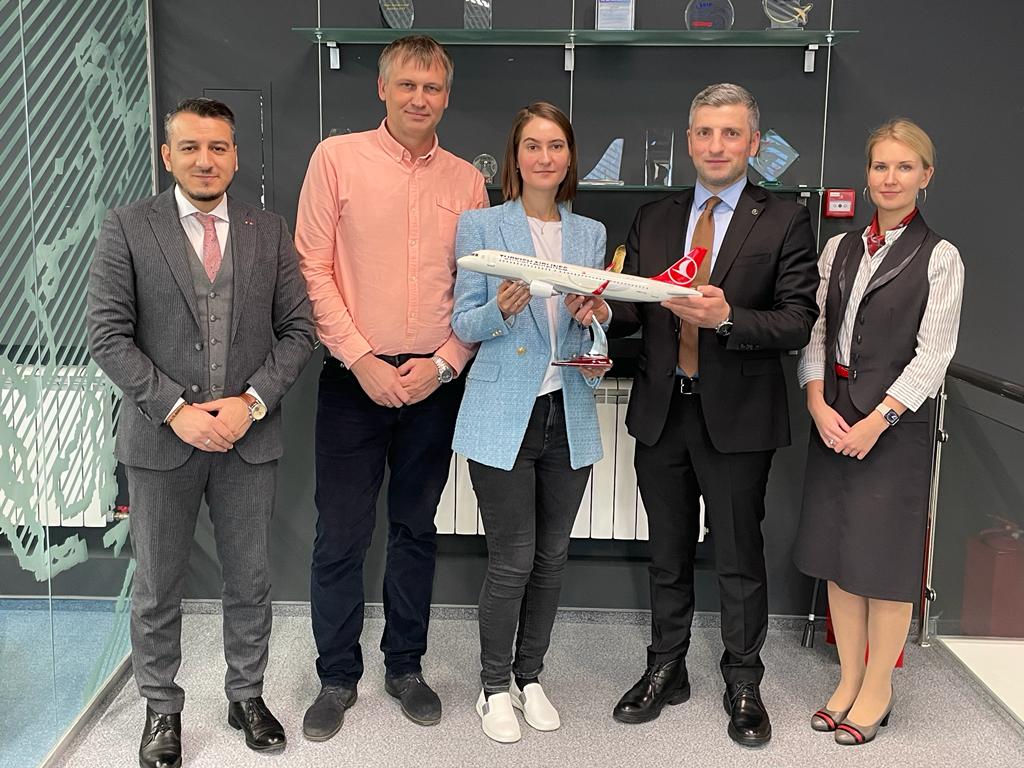
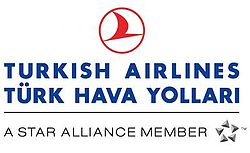 |
||
| Турецкие авиалинии Turkish Airlines Türk Hava Yolları |
||
|---|---|---|
| ИАТА TK |
ИКАО THY |
Позывной TURKISH/Tango Hotel Yankee |
| Дата основания | 1933 | |
| Хабы | Стамбул-Ататюрк | |
| Дополнительные хабы | Международный аэропорт Эсенбога Международный аэропорт имени Сабихи Гекчен |
|
| Альянс | Star Alliance | |
| Размер флота | 120 | |
| Количество пунктов назначения | 155 (32 внутр. + 123 межд.) | |
| Штаб-квартира | ||
| Руководитель | ||
| Сайт: www.thy.com |
Турецкие авиалинии (тур. Türk Hava Yolları Anonim Ortaklığı, англ. Turkish Airlines) (THY) — флагманский перевозчик Турции, базирующийся в Стамбуле. Совершает регулярные рейсы в 123 иностранных и 32 внутренних аэропортов, в Европе, Азии, Африки и США. Главным хабом авиакомпании является Международный аэропорт имени Ататюрка (IST), Стамбул, второстепенными хабами являются Международный аэропорт Эсенбога (ESB), Анкара и Международный аэропорт имени Сабихи Гекчен (SAW), Стамбул. В 2006 и 2007 через аэропорт перевезено 17 млн и 19,7 млн пассажиров соответственно.[1] Штат авиакомпании составляет около 12 000 сотрудников. С 1 апреля 2008 авиакомпания стала членом Star Alliance. Дочерними авиакомпаниями являются Anadolujet, SunExpress и B&H Airlines
Содержание
- 1 История
- 2 Назначения
- 3 Кодшеринговые соглашения
- 4 Флот
- 5 Авиакатастрофы и инциденты
- 6 См. также
- 7 References
- 8 Внешние ссылки
История
Авиакомпания была создана 20 мая 1933 года как Государственная авиационная администрация (тур. Devlet Hava Yolları İşletmesi İdaresi) (DHY). Первые рейсы осуществлялись между Стамбулом, Эскишехиром и Анкарой с августа 1933 года. В сентябре 1937 года авиакомпания получила три биплана De Havilland D.H. 86B. В декабре этого же года поступил четвёртый самолёт. Эти самолёты были задействованы на внутренних маршрутах между Стамбулом, Эскишехиром, Измиром, Анкарой, Аданой, Кайсери и Диярбакыром. Компания получила новое название — Devlet Hava Yolları Umum Müdürlüğü (DHY) в июне 1938. Первый регулярный международный рейс состоялся в 1947 году, в Афины однако открытие дальнемагистральных рейсов на Дальний Восток и через Атлантику состоялось только через 40 лет.
В результате большой реорганизации 20 февраля 1956 года авиакомпания стала смешанной корпорацией, Türk Hava Yolları. В декабре 1990 года 5 % акций были проданы. Позднее правительство продало 23.0 % акций в декабре 2004 года и 28.75 % — в мае 2006 года.
В настоящее время 49 % акций принадлежит государству и 51 % — частным владельцам. Кроме того, 50 % аффилированной авиакомпании SunExpress принадлежит Qualiflyer group в 1999 году, так как не могли быть совместимы с Swissair и Delta.
В декабре 2006 года было принято решение о вхождении Turkish Airlines в Star Alliance. С 1 апреля 2008 года Turkish Airlines вошли в альянс полноправным членом.
Назначения
-
Основная статья: :en:Turkish Airlines destinations
Турецкие авиалинии совершают рейсы из 34 аэропортов Турции, из 25 — только местные рейсы. В Анкару совершается 106 рейсов еженедельно, в Измир — около 100, Анталью — 65 и Адану 55. В десять других аэропортов дважды в день совершаются рейсы из Стамбула. Turkish Airlines являются лидером внутренних перевозок с учётом лоу-кост подразделения AnadoluJet. Конкурентами являются Onur Air, Pegasus, SunExpress (50 % которой принадлежит Turkish Airlines) и Atlasjet.
Большая часть международных рейсов Turkish Airlines совершается из Международного аэропорта имени Ататюрка в Стамбуле, откуда длительность полёта до 50 стран, куда совершаются полёты, составляет не более трёх часов. Турецкие авиалинии обслуживают 108 назначений за пределами Турции в около 70 стран. Совершаются рейсы через Атлантический океан в Нью-Йорк и Чикаго. Крупнейшими направлениями в Азии являются Бангкок, Пекин, Гонконг, Осака, Сеул, Шанхай, Сингапур и Токио.[2]
Турецкие авиалинии объявили о планируемых рейсах в Торонто, Вашингтон и Сан-Пауло; среднемагистральных рейсов в Алеппо, Бирмингем, Лахор, Атрау, Оран, Львов, Уфу и Александрию в 2008 году [1], однако в связи с задержками в поступлении новых самолётов эти сроки выдержаны не будут.
Кодшеринговые соглашения
Airbus A330-200.
Turkish Airlines заключили кодшеринговые соглашения со следующими перевозчиками, кроме авиакомпаний Star Alliance:
- Air India
- Air Malta
- Pakistan International Airlines
- Royal Air Maroc
- SunExpress
- Syrian Arab Airlines
Флот
По состоянию на 2 декабря 2008 года флот Turkish Airlines состоит из:
| Тип | Итого | Заказано | Пассажиров (Первий/Бизнес/Эконом) |
Маршруты | Примечания |
|---|---|---|---|---|---|
| Airbus A310-300 | 3 | 210 (18/192) | Африка, внутренние рейсы | Планируется вывод из эксплуатации | |
| Airbus A310-300F | 4 | грузовые | Африка, Азия, Европа и Ближний Восток | Грузовое подразделение | |
| Airbus A319-100 | 4 | 124 (12/112) | Внутренние рейсы, Европа | ||
| Airbus A320-200 | 21 | 1 | 150 (0/150) 156 (0/156) |
Внутренние рейсы, Европа | |
| Airbus A321-200 | 17 | 186 (15/171) 195 (15/180) 202 (15/187) |
Европа, Закавказье | ||
| Airbus A330-200 | 5 | 2 | 250 (22/228) | Европа, Ближний Восток, Дальний Восток, Северная Америка и африка | Системы развлечений в бизнес- и эконом классах. В заказах — аренда у Qatar Airways |
| Airbus A340-300 | 9 | 271 (34/237) | Северная Америка, Дальний Восток и Африка | Системы развлечений в бизнес- и эконом классах. 2 арендовано у ILFC |
|
| Boeing 737-400 | 9 | 150 (12/138) | Внутренние рейсы | Планируется вывод из эксплуатации. 6 передано в аренду Anadolujet, 3 будет также передано в аренду |
|
| Boeing 737-800 | 49 | 165 (40/105) конвертируемые | Внутренние рейсы, коротко- и среднемагистральные рейсы | 2 передано в аренду Anadolujet | |
| Boeing 777-300ER | 3 | 312 (8/30/274) | Сингапур, Лондон, Нью-Йорк, Гонконг, Токио | получено в мокрый лизинг от Jet Airways[2] | |
| Итого | 120 | 7 |
- Средний возраст флота составляет 7.1 лет.
- Планируется приобретение 30 Boeing 787 или Airbus A350. [3]
- Флот на декабрь 2008 включает 120 пассажирских самолётов.
Airbus A310-300.
Airbus A321-200.
Авиакатастрофы и инциденты
За 75 лет истории с самолётами Turkish Airlines произошло три авиакатастрофы на международных рейсах и 18 — на внутренних.
Первая авиакатастрофа Турецких авиалиний произошла 17 февраля 1959 года с самолётом Vickers Viscount Type 793, регистрационный номер TC-SEV, который разбился в густом тумане при приземлении в лондонском аэропорту Гатвик (см. en:1959 Turkish Airlines Gatwick crash). В самолёте среди пассажиров находился премьер-министр Турции Аднан Мендерес и правительственная делегация, направлявшиеся в Лондон на подписание Соглашения о статусе Кипра. Мендерес оказался одним из десяти выживших (на борту было 8 членов экипажа и 16 пассажиров).
Более всего жизней унесла катастрофа рейса 981, которая произошла во Франции 3 марта 1974 года, вследствие декомпрессии погибли все 346 человек на борту. Причиной стала конструкционная ошибка грузового выхода на DC-10. До авиакатастрофы на Тенерифе это была авиакатастрофа с самым большим количеством жертв.
25 февраля 2009 В амстердамском международном аэропорту Схипхол при посадке разбился самолет авиакомпании Turkish Airlines, сообщает AFP. На его борту находились 135 пассажиров и семь членов экипажа. Boeing 737 упал возле оживленной автотрассы и развалился на три части. Турецкий премьер подтвердил гибель людей, но точное число не назвал. В авиакатастрофе в амстердамском аэропорту погибли люди, заявил премьер-министр Турции Тайип Эрдоган, однако точное число жертв назвать затруднился, пишет газета Hurriyet. Относительно числа жертв крушения авиалайнера поступают противоречивые данные. По информации голландского телевидения, погибли пять человек. Первоначально турецкое телевидение сообщало, что погиб один человек. Газета De Telegraaf со ссылкой на свои источники сообщает о семи погибших, 25 тяжело раненых и 60 — с легкими травмами. Министерство транспорта Голландии, между тем, сообщает о девяти погибших. Министр транспорта Турции Бинали Йылдырым ранее заявил, что в результате катастрофы никто не погиб. К настоящему времени эвакуированы 80 человек, отмечает он. Пожара на борту не произошло. По мнению одного из выживших пассажиров, причиной катастрофы могла стать сильная турбулентность. «Я думал, что мы сядем на поле или дорогу, — рассказал турок Хусейн Сюмер в прямом эфире телекомпании CNN-Turk. — Момент падения не помню. Пришел в себя, когда самолет оказался на земле». По словам выжившего, пострадали более 40 человек: «У многих переломы рук и ног. Им оказывается экстренная помощь». Рейс TK 1951 совершал перелет из Стамбула в Амстердам. В настоящее время все полеты в зоне аварии приостановлены. Причины катастрофы пока не известны. Йылдырым заявил, что лайнер последний раз проходил ремонтные работы 22 декабря 2008 года.
См. также
- Anadolujet — «бюджетное» англ. low-cost подразделение Turkish Airlines.
- SunExpress — совместное предприятие Turkish Airlines и Анталье.
- B&H Airlines — флагманский перевозчик Боснии и Герцеговины, базируется в Сараево.
References
- ↑ ATW Daily News
- ↑ Turkish Airlines продолжает рост на 15%, anna.aero (26th September 2008).
Внешние ссылки
- Официальный сайт
- Anadolujet — лоу-кост подразделение Turkish Airlines
- SunExpress — подразделение Turkish Airlines
- Accident report on Turkish Airlines
Wikimedia Foundation.
2010.





